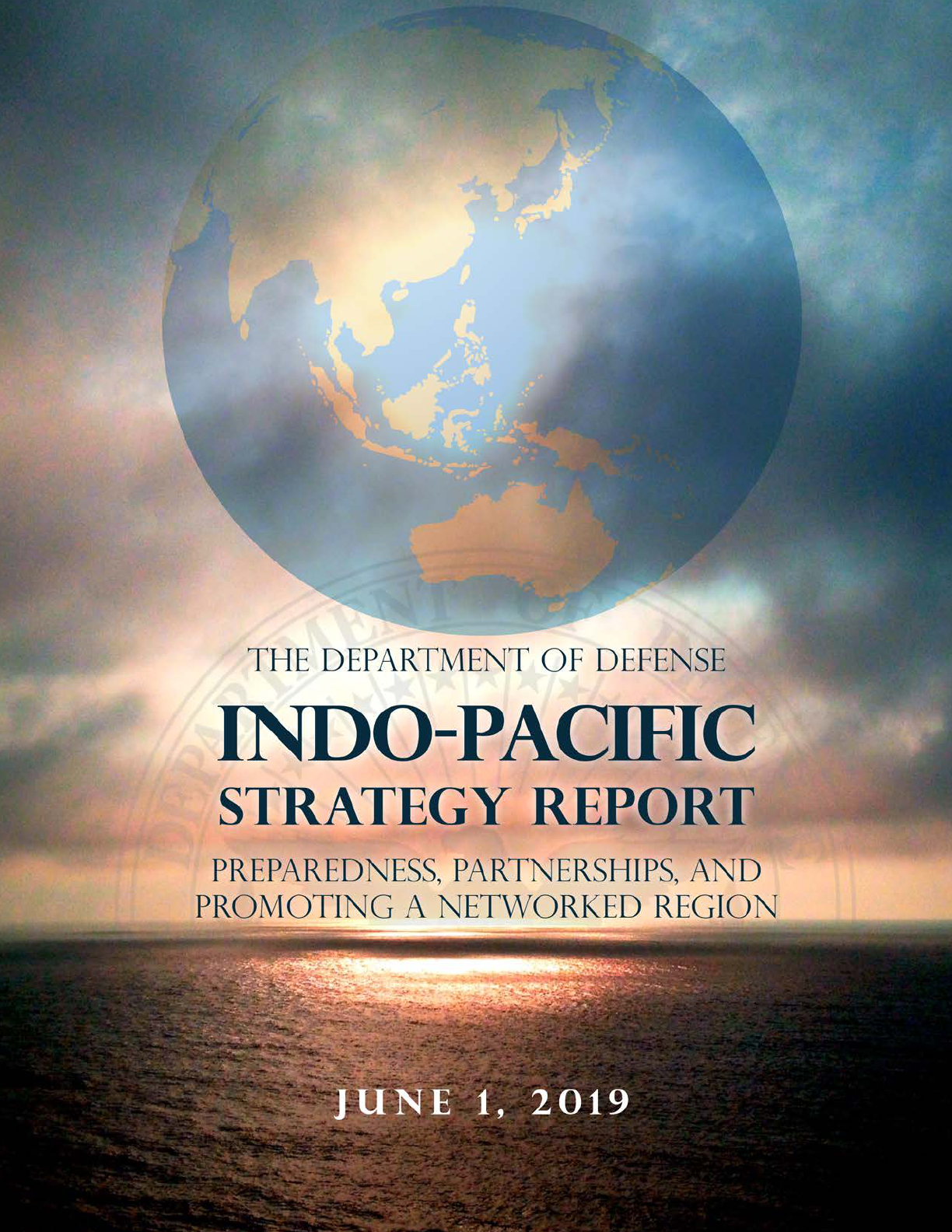
This page left intentionally blank

THE DEPARMENT OF DEFENSE
Indo-Pacific Strategy Report
Preparedness, Partnerships, and Promoting a Networked Region
June 1, 2019
The estimated cost of this report or study for the
Department of Defense is approximately $128,000 for
the 2019 Fiscal Year. This includes $18,000 in expenses
and $110,000 in DoD labor.
Generated on 2019June01 RefID: 0-1C9F36A

MESSAGE FROM THE SECRETARY OF DEFENSE
he Indo-Pacific is the Department of Defense’s priority theater. The United
States is a Pacific nation; we are linked to our Indo-Pacific neighbors
through unbreakable bonds of shared history, culture, commerce, and
values. We have an enduring commitment to uphold a free and open Indo-
Pacific in which all nations, large and small, are secure in their sovereignty and able to
pursue economic growth consistent with accepted international rules, norms, and
principles of fair competition.
The continuity of our shared strategic vision is uninterrupted despite an increasingly
complex security environment. Inter-state strategic competition, defined by
geopolitical rivalry between free and repressive world order visions, is the primary
concern for U.S. national security. In particular, the People’s Republic of China, under
the leadership of the Chinese Communist Party, seeks to reorder the region to its
advantage by leveraging military modernization, influence operations, and predatory
economics to coerce other nations.
In contrast, the Department of Defense supports choices that promote long-term
peace and prosperity for all in the Indo-Pacific. We will not accept policies or actions
that threaten or undermine the rules-based international order – an order that benefits
all nations. We are committed to defending and enhancing these shared values.
The National Security Strategy and the National Defense Strategy articulate our vision to
compete, deter, and win in this environment. Achieving this vision requires combining
a more lethal Joint Force with a more robust constellation of allies and partners.
Increased investments in these imperatives will sustain American influence in the
region to ensure favorable balances of power and safeguard the free and open
international order.
This 2019 Department of Defense Indo-Pacific Strategy Report (IPSR) affirms the
enduring U.S. commitment to stability and prosperity in the region through the pursuit
of preparedness, partnerships, and the promotion of a networked region.
T

Preparedness – Achieving peace through strength and employing effective
deterrence requires a Joint Force that is prepared to win any conflict from its
onset. The Department, alongside our allies and partners, will ensure our
combat-credible forces are forward-postured in the region. Furthermore, the
Joint Force will prioritize investments that ensure lethality against high-end
adversaries.
Partnerships – Our unique network of allies and partners is a force multiplier
to achieve peace, deterrence, and interoperable warfighting capability. The
Department is reinforcing its commitment to established alliances and
partnerships, while also expanding and deepening relationships with new
partners who share our respect for sovereignty, fair and reciprocal trade, and
the rule of law.
Promotion of a Networked Region – The Department is strengthening and
evolving U.S. alliances and partnerships into a networked security architecture
to uphold the international rules-based order. The Department also continues
to cultivate intra-Asian security relationships capable of deterring aggression,
maintaining stability, and ensuring free access to common domains.
Advancing this Indo-Pacific vision requires an integrated effort that recognizes the
critical linkages between economics, governance, and security – all fundamental
components that shape the region’s competitive landscape. The Department of
Defense, in partnership with other U.S. Government Departments and Agencies,
regional institutions, and regional allies and partners, will continue to diligently uphold
a rules-based order that ensures peace and prosperity for all.
Patrick M. Shanahan
Acting Secretary of Defense
This page left intentionally blank
Indo- Pacific Strategy Report
Contents
1. Introduction ........................................................................................................................ 1
1.1. America’s Historic Ties to the Indo-Pacific ............................................................ 2
1.2. Vision and Principles for a Free and Open Indo-Pacific ....................................... 3
2. Indo-Pacific Strategic Landscape: Trends and Challenges ............................................ 7
2.1. The People’s Republic of China as a Revisionist Power........................................ 7
2.2. Russia as a Revitalized Malign Actor ...................................................................... 11
2.3. The Democratic People’s Republic of Korea as a Rogue State .......................... 12
2.4. Prevalence of Transnational Challenges ................................................................ 13
3. U.S. National Interests and Defense Strategy ............................................................... 15
3.1. U.S. National Interests ............................................................................................. 15
3.2. U.S. National Defense Strategy ............................................................................... 16
4. Sustaining U.S. Influence to Achieve Regional Objectives ......................................... 17
4.1. Line of Effort 1: Preparedness ................................................................................ 17
4.2. Line of Effort 2: Partnerships ................................................................................. 21
4.3. Line of Effort 3: Promoting a Networked Region ............................................... 44
Conclusion ............................................................................................................................. 53
Acronyms .............................................................................................................................. 55
Indo- Pacific Strategy Report
This page left intentionally blank

Indo- Pacific Strategy Report
1
1. Introduction
he Indo-Pacific is the single most consequential region for America’s future. Spanning a vast
stretch of the globe from the west coast of the United States to the western shores of India,
the region is home to the world’s most populous state, most populous democracy, and largest
Muslim-majority state, and includes over half of the earth’s population. Among the 10 largest
standing armies in the world, 7 reside in the Indo-Pacific; and 6 countries in the region possess nuclear
weapons. Nine of the world’s
10 busiest seaports are in the
region, and 60 percent of global
maritime trade transits through
Asia, with roughly one-third of
global shipping passing through
the South China Sea alone.
The United States is a Pacific
nation and has five Pacific states: Hawaii, California, Washington, Oregon, and Alaska, as well as
Pacific territories on both sides of the International Date Line, including: Guam, American Samoa,
T
“The story of the Indo-Pacific in recent decades is
the story of what is possible when people take
ownership of their future…this region has emerged
as a beautiful constellation of nations, each its own
bright star, satellites to none.”
- President Donald J. Trump, speech at the APEC CEO Summit,
November 10, 2017

Indo- Pacific Strategy Report
2
Wake Island, and the Commonwealth of Northern Mariana Islands (CNMI). American businesses
have traded in Asia since the 18th century, and today, within the Asia-Pacific Economic Cooperation
(APEC), America’s annual two-way trade with the region is $2.3 trillion, with U.S. foreign direct
investment of $1.3 trillion in the region – more than China’s, Japan’s, and South Korea’s combined.
The Indo-Pacific contributes two-thirds of global growth in gross domestic product (GDP) and
accounts for 60 percent of global GDP. This region includes the world’s largest economies – the
United States, China, and Japan – and six of the world’s fastest growing economies – India, Cambodia,
Laos, Burma, Nepal, and the Philippines. A quarter of U.S. exports go to the Indo-Pacific, and exports
to China and India have more than doubled over the past decade. This is made possible by free and
open trade routes through the air, sea, land, space, and cyber commons that form the current global
system.
1.1. America’s Historic
Ties to the Indo-Pacific
The United States is a Pacific nation. Our
ties to the Indo-Pacific are forged by
history, and our future is inextricably
linked. We have contributed both blood
and treasure to sustain the freedoms,
openness, and opportunity of this region.
Our presence secures the vital sea lanes of
the Indo-Pacific that underpin global
commerce and prosperity. Our leaders,
diplomats, military forces, and businesses
helped frame and strengthen the international system of clear and transparent rules; peaceful
resolution of disputes; and the rule of law that has been vital to the region’s relative security and
growing prosperity.
The past, present, and future of the United States are interwoven with the Indo-Pacific. Our
engagement in the Indo-Pacific dates back more than two centuries, based on the pursuit of the shared
prosperity that comes from fair and reciprocal trade, open commerce, and freedom of navigation. In
1784, within months of signing the Treaty of Paris, the United States sent a trading ship, the
EMPRESS OF CHINA to inaugurate commercial ties with China. In 1804, President Thomas
Jefferson sent the explorers – Lewis and Clark – on an expedition to our Pacific Coast, which Jefferson
recognized as the gateway for increased trade and commerce. By 1817, Congress approved the first
full-time Pacific deployment of a U.S. warship. In the early 19th century, we began our relationship
with the Kingdom of Thailand and thereafter negotiated to open Japan to global trade in the 1850s.
“Starting in the Indo-
Pacific, our priority
theater, we continue to pursue many belts
and many roads by keeping our decades-old
alliances strong and fostering growing
partnerships.”
- Acting Secretary of Defense Patrick M. Shanahan,
testimony to the Senate Armed Services Committee,
March 14, 2019

Indo- Pacific Strategy Report
3
At the close of the 19th century, the United States established an “Open Door” policy towards China,
promoting equal opportunity for trade and commerce in China, and respect for China’s sovereignty.
In the 20th century, the United States expanded its role in the region as we confronted imperialism
and fascism and held the line against communism during the Cold War. The early 1950s marked
several milestones – the signing of the Mutual Defense Treaty between the Republic of the Philippines
and the United States in August 1951 and the signing of the Australia, New Zealand, and United States
Security Treaty in September 1951 – both of which sought to bring stability to the region. In the
seven decades that followed the Second World War, based on a foundation of the U.S. system of
alliances and our forward deployed forces, the Indo-Pacific was largely peaceful, and we helped create
the stability necessary for economic prosperity in the United States and the region.
In pursuit of partnership, not domination, the United States worked with Japan and South Korea after
the Second World War to forge alliances and stimulate an economic boom in both countries. In
Taiwan, U.S. aid helped create an open, democratic society that allowed the island to blossom into a
high-tech powerhouse. In the 1970s and 1980s, the United States invested in Hong Kong, Singapore,
and other Southeast Asian economies and supported foundational institutions like the Association for
Southeast Asian Nations (ASEAN), the APEC Forum, and the Asian Development Bank, all
contributing to growth in the region. Simultaneously, the United States established formal diplomatic
relations with China in 1979, which facilitated economic exchange and extended America’s consistent
policy approach of a free, open market and equal trading opportunity for merchants of all nationalities
operating in the region. At the turn of the 21st century, the United States advocated for China’s
admission into the World Trade Organization, with the belief that economic liberalization would bring
China into a greater partnership with the United States and the free world.
As history has demonstrated and the future necessitates, the United States will continue to play a key
role as a force for regional stability in the Indo-Pacific in support of U.S. diplomatic and economic
aspirations. To do so, the United States must be prepared by sustaining a credible combat-forward
posture; strengthening alliances and building new partnerships; and promoting an increasingly
networked region. These actions will enable the United States to preserve a free and open Indo-
Pacific where sovereignty, independence, and territorial integrity are safeguarded.
1.2. Vision and Principles for a
Free and Open Indo-Pacific
In 2017, President Trump announced our nation’s vision for a
free and open Indo-Pacific
at the
APEC Summit in Vietnam, and our commitment to a safe, secure, prosperous, and free region that
benefits all nations. This vision flows from common principles that underpin the current international
order, which has benefited all countries in the region – principles we have a shared responsibility to
uphold:

Indo- Pacific Strategy Report
4
1. Respect for sovereignty and independence of all nations;
2. Peaceful resolution of disputes;
3. Free, fair, and reciprocal trade based on open investment, transparent agreements, and
connectivity; and,
4. Adherence to international rules and norms, including those of freedom of navigation and
overflight.
Our vision for a
free
Indo-Pacific is one
in which all nations, regardless of size,
are able to exercise their sovereignty free
from coercion by other countries. At
the national-level, this means good
governance and the assurance that
citizens can enjoy their fundamental
rights and liberties. Our vision for an
open
Indo-Pacific is one that promotes
sustainable growth and connectivity in
the region. This means all nations enjoy access to international waters, airways, and cyber and space
domains, and are able to pursue peaceful resolution of territorial and maritime disputes. On an
economic level, this means fair and reciprocal trade, open investment environments, and transparent
agreements between nations.
Our vision for a free and open Indo-Pacific recognizes the linkages between economics, governance,
and security that are part of the competitive landscape throughout the region, and that economic
security is national security. In order to achieve this vision, we will uphold the rule of law, encourage
resilience in civil society, and promote transparent governance – all of which expose malign influences
that threaten economic development everywhere. Our vision aspires to a regional order in which
independent nations can both defend their interests and compete fairly in the international
marketplace. It is a vision which recognizes that no one nation can or should dominate the Indo-
Pacific.
In recognition of the region’s need for greater investment, including infrastructure investment, the
United States seeks to invigorate our development and finance institutions to enable us to become
better, more responsive partners. U.S. Departments and Agencies will work with regional allies and
partners to provide end-to-end solutions that build tangible products and transfer experience.
Ultimately, the maintenance of a free and open order sustains regional development because a well-
functioning and transparent marketplace incentivizes global commercial investments that outpaces
any state’s unique resources. The United States is not alone in its pursuit of a free and open Indo-
Pacific – many of our allies and partners share these principles and values:
“The U.S. offers strategic partnerships, not
strategic dependence. Alongside our allies
and partners, America remains committed
to maintaining the region’s security, its
stability, and its economic prosperity.”
- Then-Secretary of Defense James N.
Mattis, speech at the Shangri-La
Dialogue, June 1, 2018

Indo- Pacific Strategy Report
5
“We must ensure that these waters are a public good that bring
peace and prosperity to all people without discrimination into
the future.”
- Prime Minister of Japan, Shinzo Abe, policy speech to the 196
th
session of the Diet
January 22, 2018
“Now what is important is to preserve a rules-based
development in the region. It’s to preserve the necessary
balances in the region.”
- President of France, Emmanuel Macron, speech during a state visit to Australia
May 2, 2018
“…rules and norms should be based on the consent of all, not
on the power of the few.”
- Prime Minister of India, Narendra Modi, keynote address at the Shangri-La Dialogue
June 1, 2018
“We want a rules-based system that respects the sovereignty and
the independence of every single country and a commitment
then to regional security that is always the precondition for
prosperity.”
- Prime Minister of Australia, Scott Morrison, address at the APEC CEO Summit
November 17, 2018
“Collective solutions to shared challenges in the Pacific require
strong and vibrant regionalism, with institutions that can
convert political will into action, supported by partners who
align their efforts with the region’s priorities.”
- Deputy Prime Minister and Minister of Foreign Affairs for New Zealand, Winston
Peters, address at Georgetown University
December 15, 2018
Indo- Pacific Strategy Report
6
A free and open Indo-Pacific rests on a foundation of mutual respect, responsibility, priorities, and
accountability. While we unapologetically represent U.S. values and beliefs, we do not seek to impose
our way of life on others. In order to maintain the regional dynamism that benefits all, each country
in the region has a shared responsibility to contribute and sustain it – for the regional order will not
survive on its own. We will uphold our commitments, but we will rely on allies and partners to
contribute their fair share, including by investing to modernize their defense capabilities.
Advancing this vision is a whole-of-government priority that draws on the strengths and values of
American society. As Secretary of State Michael Pompeo has said, “The American people and the
whole world have a stake in the Indo-Pacific’s peace and prosperity. It’s why the Indo-Pacific must
be free and open.”
Our whole-of-government commitment was reflected at the Indo-Pacific Business Forum in 2018, as
Secretary of State Pompeo, Secretary of Commerce Wilbur Ross, U.S. Agency for International
Development Administrator Mark Green, and other Cabinet-level officials launched new initiatives to
expand U.S. public and private investment in Indo-Pacific infrastructure, energy markets, and digital
economy. We also established new development finance partnerships with Japan, Australia, Canada,
and the European Union, supported by significant new resources and authorities in the Better
Utilization of Investments Leading to Development Act or the BUILD Act, which President Trump
signed into law in October 2018. The following month, Vice President Michael Pence announced
efforts to coordinate with Japan on $10 billion in regional energy investment, establish a U.S.-ASEAN
Smart Cities Partnership, and launch a five-country partnership for electrification in Papua New
Guinea. The Vice President also announced the Indo-Pacific Transparency Initiative to help countries
attract high-quality investment and counter corruption and coercive threats to their sovereignty, by
strengthening civil society and good governance. Furthermore, the Asia Reassurance Initiative Act, a
major bipartisan legislation, was signed into law by President Trump on December 31, 2018. This
legislation enshrines a generational whole-of-government policy framework that demonstrates U.S.
commitment to a free and open Indo-Pacific region and includes initiatives that promote sovereignty,
rule of law, democracy, economic engagement, and regional security.
As the region grows in population and economic weight, U.S. strategy will adapt to ensure that the
Indo-Pacific is increasingly a place of peace, stability, and growing prosperity – and not one of
disorder, conflict, and predatory economics. Embedding these free and open principles will require
efforts across the spectrum of our agencies and capabilities: diplomatic initiatives, governance capacity
building, economic cooperation and commercial advocacy, and military cooperation.

Indo- Pacific Strategy Report
7
2.
Indo-Pacific Strategic
Landscape: Trends and Challenges
2.1. The People’s Republic of China
as a Revisionist Power
China’s economic, political, and military rise is one of the defining elements of the 21st century.
Today, the Indo-Pacific increasingly is confronted with a more confident and assertive China that is
willing to accept friction in the pursuit of a more expansive set of political, economic, and security
interests.
Perhaps no country has benefited more from the free and open regional and international system than
China, which has witnessed the rise of hundreds of millions from poverty to growing prosperity and
security. Yet while the Chinese people aspire to free markets, justice, and the rule of law, the People’s
Republic of China (PRC), under the leadership of the Chinese Communist Party (CCP), undermines
the international system from within by exploiting its benefits while simultaneously eroding the values
and principles of the rules-based order. With more than half of the world’s Muslim population living

Indo- Pacific Strategy Report
8
in the Indo-Pacific, the region views the PRC’s systematic mistreatment of Uighurs, Kazakhs, and
other Muslims in Xinjiang – including pervasive discrimination, mass detention, and disappearances
– with deep concern. China’s violation of international norms also extends abroad. Chinese nationals
acting in association with the Chinese Ministry of State Security were recently indicted for conducting
global campaigns of cyber theft that targeted intellectual property and confidential business and
technological information at managed service providers. China has continued to militarize the South
China Sea by placing anti-ship cruise missiles and long-range surface-to-air missiles on the disputed
Spratly Islands and employing paramilitary forces in maritime disputes vis-à-vis other claimants. In
the air, the People’s Liberation Army (PLA) has increased patrols around and near Taiwan using
bomber, fighter, and surveillance aircraft to signal Taiwan. China additionally employs non-military
tools coercively, including economic tools, during periods of political tensions with countries that
China accuses of harming its national interests.
The People’s Republic of China’s Military Modernization
and Coercive Actions
As China continues its economic and military ascendance, it seeks Indo-Pacific regional hegemony in
the near-term and, ultimately global preeminence in the long-term. China is investing in a broad range
of military programs and weapons, including those designed to improve power projection; modernize
its nuclear forces; and conduct increasingly complex operations in domains such as cyberspace, space,
and electronic warfare operations. China is also developing a wide array of anti-access/area denial
(A2/AD) capabilities, which could be used to prevent countries from operating in areas near China’s
periphery, including the maritime and air domains that are open to use by all countries.
In 2018, China’s placement of anti-ship cruise missiles and long-range surface-to-air missiles on the
disputed Spratly Islands violated a 2015 public pledge by the Chairman of the CCP Xi Jinping that
“China does not intend to pursue militarization” of the Spratly Islands. China’s use of military
presence in an attempt to exert de facto control over disputed areas is not limited to the South China
Sea. In the East China Sea, China patrols near the Japan-administered Senkaku Islands with maritime
law enforcement ships and aircraft. These actions endanger the free flow of trade, threaten the
sovereignty of other nations, and undermine regional stability. Such activities are inconsistent with
the principles of a free and open Indo-Pacific.
Simultaneously, China is engaged in a campaign of low-level coercion to assert control of disputed
spaces in the region, particularly in the maritime domain. China is using a steady progression of small,
incremental steps in the “gray zone” between peaceful relations and overt hostilities to secure its aims,
while remaining below the threshold of armed conflict. Such activities can involve the coordination
of multiple tools, including: political warfare, disinformation, use of A2/AD networks, subversion,
and economic leverage.
During the last decade, China continued to emphasize capabilities for Taiwan contingencies. China
has never renounced the use of military force against Taiwan, and continues to develop and deploy

Indo- Pacific Strategy Report
9
advanced military capabilities needed for a potential military campaign. PLA modernization is also
strengthening its ability to operate farther from China’s borders. For example, the PLA is reorganizing
to improve its capability to conduct complex joint operations, and is also improving its command and
control, training, personnel, and logistics systems. Key weapon systems deployed or in development,
include: cruise and ballistic missile systems, modern fighter and bomber aircraft, aircraft carriers,
modern ships and submarines, amphibious assault ships, surface-to-air missile systems, electronic
warfare systems, direct-ascent, hit-to-kill anti-satellite missiles, and autonomous systems.
China’s Use of Economic Means to Advance Its Strategic Interests
China is using economic inducements
and penalties, influence operations, and
implied military threats to persuade
other states to comply with its agenda.
Although trade has benefitted both
China and its trade partners, Chinese use
of espionage and theft for economic
advantage, as well as diversion of
acquired technology to the military,
remains a significant source of
economic and national security risk to all
of China’s trading partners.
While investment often brings benefits
for recipient countries, including the United States, some of China’s investments result in negative
economic effects or costs to host country sovereignty. Chinese investment and project financing that
bypasses regular market mechanisms results in lower standards and reduced opportunities for local
companies and workers, and can result in significant debt accumulation. One-sided and opaque deals
are inconsistent with the principles of a free and open Indo-Pacific, and are causing concern in the
region. For example, in 2018, Bangladesh was forced to ban one of China’s major state firms for
attempted bribery, and in the same year, Maldives’ finance minister stated that China was building
infrastructure projects in the country at significantly inflated prices compared to what was previously
agreed. Furthermore, a Chinese state-owned enterprise purchased operational control of Hambantota
Port for 99 years, taking advantage of Sri Lanka’s need for cash when its government faced daunting
external debt repayment obligations.
The United States does not oppose China’s investment activities as long as they respect sovereignty
and the rule of law, use responsible financing practices, and operate in a transparent and economically
sustainable manner. The United States, however, has serious concerns with China’s potential to
convert unsustainable debt burdens of recipient countries or sub-national groups into strategic and
military access, including by taking possession of sovereign assets as collateral. China’s coercive
behavior is playing out globally, from the Middle East and Africa to Latin America and Europe.
“B
eijing is leveraging its economic
instrument
of power in ways that can
undermine the autonomy of countries across
the region…easy money in the short term,
but these funds come with strings attached:
unsustainable debt, decreased transparency,
restrictions on market economies, and the
potential loss of control of natural
resources.”
- Admiral Philip S. Davidson, Commander, U.S. Indo-Pacific
Command, posture testimony before the Senate Armed
Services Committee, February 12, 2019

Indo- Pacific Strategy Report
10
A lack of transparency also clouds China’s activities in the
polar regions. In 2018, China announced the inclusion of the
region in One Belt One Road as the “Polar Silk Road” and
emphasized its self-declared status as a “Near-Arctic State.”
China is also expanding its engagement and capabilities in the
Antarctic, in particular by working to finalize a fifth research
station, which will diversify its presence across the continent.
Risk Reduction: Engaging China
One of the most far-
reaching objectives of the
National Defense Strategy
is to set the military
relationship between the United States and China on
a long-term path of transparency and non-
aggression.
Pursuit of a constructive, results-oriented relationship
between our two countries is an important part of
U.S. strategy in the Indo-Pacific.
As the scope of China’s military modernization and
the reach of China’s military activities expands, the
need for strategic dialogue and safe and professional
behavior consistent with international law is crucial.
When China and the PLA operate
in a manner
consistent with international norms and standards,
the risk of miscalculation and misunderstanding is
reduced. Recognizing this, our bilateral military
engagements with China, which include high-level
visits, policy dialogues, and functional exchanges, are
centered on building and reinforcing the procedures
necessary to reduce risk and prevent and manage
crises.
Through our military-to-
military engagements, the
Department of Defense will continue to encourage
China to engage in behaviors that maintain peace and
stability in the region and that support
– rather than
undermine
– the rules-based international order. We
will not accept policies or actions that threaten to
undermine this order, which has benefited all
countries in the region, including China. The United
States is prepared to support China’s choices to the
extent that China promotes long-
term peace and
prosperity for all in the Indo-Pacific, and we remain
open to cooperate where our interests align.
On October 5, 2018, President
Trump signed into law the Better
Utilization of Investments Leading
to Development (BUILD) Act. The
BUILD Act establishes a new U.S.
International Development Finance
Corporation.
This legislation
consolidates, modernizes, and
reforms the
U.S. Government’s
development finance capabilities.
Backing from the U.S. Government
can catalyze significant amounts of
private capital into emerging
markets. This model of mobilizing
private investment is vital as the
needs of developing countries are
too great to meet with official
government resources alone. The
BUILD Act prioritizes low-income
and lower middle-income countries,
where the Development Finance
Corporation’s services will have the
greatest impact. It more than
doubles the U.S. development
finance capacity from $29 billion to
$60 billion. The new authorities and
flexibility provided under the
BUILD Act will give the United
States greater agility to offer
financially sound, transparent
investment alternatives.
THE BUILD ACT

Indo- Pacific Strategy Report
11
2.2. Russia as a Revitalized Malign Actor
Russia’s interest and influence in the region continue to increase through national outreach and
military modernization – in both its conventional forces and strategic forces. Despite slow economic
growth due to Western sanctions and decreasing oil prices, Russia continues to modernize its military
and prioritize strategic capabilities – including its nuclear forces, A2/AD systems, and expanded
training for long-range aviation – in an attempt to re-establish its presence in the Indo-Pacific region.
Russia’s operations and engagement throughout this region are consistent with its global influence
activities, which seek to advance Moscow’s strategic interests while undermining U.S. leadership and
the rules-based international order.
Russia’s efforts include using economic, diplomatic, and military means to achieve influence in the
Indo-Pacific region. Moscow seeks to alleviate some of the effects of sanctions imposed, following
its aggressive actions in Ukraine, by diplomatically appealing to select states in Asia and seeking
economic opportunities for energy exports. Russia also seeks to increase defense and trade relations
through arms sales in the region.
Russia is re-establishing its military
presence in the Indo-Pacific by
regularly flying bomber and
reconnaissance missions in the Sea of
Japan and conducting operations as far
east as Alaska and the west coast of the
continental United States. Russia has
also intensified its diplomatic outreach
in Southeast Asia, seeking to capitalize
on U.S.-China tensions in order to
present itself as a neutral “third
partner.” The Russian Navy has
increased its operations and reach, with
the Russian Pacific Fleet deploying ships to support operations in the Middle East and Europe, and
the Russian Baltic and Black Sea Fleets deploying to the Indo-Pacific. Russian ballistic missile and
attack submarines remain active in the region, while Russia is also undertaking efforts to modernize
its conventional forces and nuclear strike capabilities.
China and Russia collaborate across the diplomatic, economic, and security arenas. China has
increased investment in Russia's economy and Russia is one of China's top sources for energy imports.
In the security realm, China purchases advanced equipment such as Su-35 fighter aircraft and the
S-400 surface-to-air missile system from Russia. The two countries participate in bilateral and
multilateral military exercises together, including China's 2018 participation for the first time in
Russia's annual strategic command and staff exercise, VOSTOK (East) 2018. China and Russia
“For decades, the U.S. led the world in
hypersonics research – and deliberately chose
not to weaponize these systems. China and
Russia have chosen differently. Our nation
does not seek adversaries, but we will not
ignore them either. We refuse to be bound by
geography. Our new, space-
based sensor
layer will give us persistent, timely, global
awareness.”
- Acting Secretary Shanahan, remarks on the 2019
Missile Defense Review, January 17, 2019

Indo- Pacific Strategy Report
12
frequently jointly oppose U.S.-sponsored measures at the United Nations Security Council. Broadly,
they share a preference for a multipolar world order in which the United States is weaker and less
influential. Russia has Arctic interests linked to its significant Arctic Ocean coastline and the
extraction of natural resources. This is witnessed by Russia’s extended continental shelf claim, and an
uptick in its military posture and investments to develop the region and the Northern Sea shipping
route, including with Chinese involvement. However, an interest in reserving Arctic resources for
littoral states may ultimately limit the extent and depth of Sino-Russian cooperation.
2.3. The Democratic People’s Republic
of Korea as a Rogue State
The Democratic People’s Republic of Korea (DPRK or North Korea) will remain a security challenge
for DoD, the global system, our allies and partners, and competitors, until we achieve the final, fully
verifiable denuclearization as committed to by Chairman Kim Jong Un. Although a pathway to peace
is open for a diplomatic resolution of North Korea’s nuclear weapons program, other weapons of
mass destruction, missile threats, and the security challenges North Korea presents are real and
demand continued vigilance. North Korea’s history as a serial proliferator, including conventional
arms, nuclear technology, ballistic missiles, and chemical agents to countries, such as Iran and Syria,
adds to our security concerns. Furthermore, the DPRK’s continued human rights violations and abuse
against its own people, including violations of individuals’ freedom of expression, remain an issue of
deep concern to the international community. The United States also continues to support Japan's
position that North Korea must completely resolve the issue of Japanese abductees, and has raised
this with North Korean authorities.
North Korea has developed an intercontinental ballistic missile intended to be capable of striking the
continental United States with a nuclear or conventional payload. In 2017, North Korea conducted a
series of increasingly complex ballistic missile launches eastward toward the United States. North
Korea did so by overflying Japan with long-range ballistic missiles. Some tests were done at highly
lofted trajectories designed to simulate flights at ranges that could reach the United States.
North Korea poses a conventional threat to U.S. allies, such as the Republic of Korea (ROK) and
Japan. North Korea has long-range artillery arrayed against the ROK – particularly the Greater Seoul
Metropolitan Area – capable of inflicting catastrophic damage on ROK civilians and large numbers
of U.S. citizens. North Korea has demonstrated willingness to use lethal force to achieve its ends. In
2010, North Korea sank the ROK corvette CHEONAN and killed 46 sailors in an unprovoked attack.
In 2010, it also shelled the ROK Yeonpyeong Island in the Yellow Sea, killing 2 civilians and 2 military
personnel and wounding 22 more.
North Korea continues to circumvent international sanctions and the U.S.-led pressure campaign
through diplomatic engagement, counter pressure against the sanctions regime, and direct sanctions

Indo- Pacific Strategy Report
13
evasion. Early in 2018, North Korea exceeded its sanctioned limit on refined petroleum imports
through illicit ship-to-ship transfers. U.S. Indo-Pacific Command (USINDOPACOM) is working
with allies and partners to enforce United Nations Security Council Resolutions (UNSCR) by
disrupting illicit ship-to-ship transfers, often near or in Chinese territorial waters, and in the Yellow
Sea. North Korea is also engaged in cross-border smuggling operations and cyber-enabled theft to
generate revenue, while simultaneously circumventing United Nations Security Council prohibitions
on coal exports.
The Trump Administration has pursued leader-level diplomacy with North Korea for the first time,
which has highlighted unique opportunities for a brighter future for North Korea. Until North Korea
clearly and unambiguously makes the strategic decision to take steps to denuclearize, the United States
will continue to enforce all applicable domestic and international sanctions, and DoD will remain
ready to deter, and if necessary, defeat any threats to the United States, the ROK, Japan, or our other
allies and partners.
2.4. Prevalence of Transnational
Challenges
The Indo-Pacific region continues to experience a myriad of security challenges from a range of
transnational threats, including: terrorism; illicit arms; drug, human, and wildlife trafficking; and piracy,
as well as dangerous pathogens, weapons proliferation, and natural disasters. Multiple terrorist
organizations, including the Islamic State of Iraq and Syria (ISIS), operate in countries throughout the
region. The heavily-traveled Indo-Pacific sea lanes are targets for pirates seeking to steal goods or
hold ships and crews for ransom. Illegal, unreported, and unregulated fishing further challenges
regional peace and prosperity. A region already prone to earthquakes and volcanoes as part of the
Pacific Ring of Fire, the Indo-Pacific region suffers regularly from natural disasters including
monsoons, hurricanes, and floods to earthquakes and volcanic activity, as well as the negative
consequences of climate change.
Another issue of concern is weak and illiberal governance in countries. Governments that are not
responsive to the will of their people are more susceptible to malign external influence. For example,
democratic backsliding in Cambodia has taken place since 2017, when the ruling party banned
independent media and dissolved the main opposition party. Additionally, we remain concerned about
reports that China is seeking to establish bases or a military presence on its coast, a development that
would challenge regional security and signal a clear shift in Cambodia’s foreign policy orientation. In
Burma, the lack of a robust democracy has set conditions for human rights atrocities committed by
Burmese security forces in northern Rakhine State since August 2017, and has created regional
instability, with more than one million Rohingya refugees currently in Bangladesh.
Indo- Pacific Strategy Report
14
The United States is encouraged by positive indicators within South and Southeast Asia that
democratic institutions are on an upward trajectory and steadily improving transparency,
responsibility, and democratic values. These indicators include freedom of the press, civilian control
of the military, and free and fair elections in countries such as the Philippines, Malaysia, and Indonesia,
each of which experienced autocratic rule in the past.
In South Asia, Sri Lanka and the Maldives are also on a positive trajectory. In Sri Lanka, after 25 years
of conflict, the government has transitioned to a constitutional, multiparty republic with a freely-
elected President and Parliament. The political system was challenged with a constitutional dispute in
late 2018. Ultimately, however, all parties respected the Supreme Court ruling that returned
democratic processes and norms, and the military remained uninvolved throughout the dispute. The
Republic of Maldives’ historic election in 2018 – with 90 percent of the eligible population voting –
ushered in the new president, who has outlined an agenda for sweeping reforms to promote free
media, an independent judiciary, and transparent public financial management.

Indo- Pacific Strategy Report
15
3. U.S. National Interests
and Defense Strategy
3.1. U.S. National Interests
he 2017 U.S. National Security Strategy is based upon the view that peace, security, and prosperity
depend on strong, sovereign nations that respect their citizens at home and cooperate to
advance peace abroad. It is grounded in the belief that U.S. leadership in promoting these
widely held principles is a lasting force for good in the world. As such, DoD is working to support
enduring U.S. national interests, as articulated in the National Security Strategy:
1. Protect the American people, the homeland, and the American way of life;
2. Promote American prosperity through fair and reciprocal economic relationships to address
trade imbalances;
3. Preserve peace through strength by rebuilding our military so that it remains preeminent,
and rely on allies and partners to shoulder a fair share of the burden of responsibility to protect
against common threats; and,
T

Indo- Pacific Strategy Report
16
4. Advance American influence by competing and leading in multilateral organizations so that
American interests and principles are protected.
While these interests are global in nature, they assume a heightened significance in a region as
strategically and economically consequential as the Indo-Pacific.
3.2. U.S. National Defense Strategy
The 2018 National Defense Strategy guides the Department of Defense to support the National Security
Strategy in order to:
1. Defend the homeland;
2. Remain the preeminent military power in the world;
3. Ensure the balances of power in key regions remain in our favor; and
4. Advance an international order that is most conducive to our security and prosperity.
Both the National Security Strategy and the National Defense Strategy affirm the Indo-Pacific as critical for
America's continued stability, security, and prosperity. The United States seeks to help build an Indo-
Pacific where sovereignty and territorial integrity are safeguarded, the promise of freedom is fulfilled,
and prosperity prevails for all. We stand ready to cooperate with all nations to achieve this vision.
The National Defense Strategy informs how we work with our neighbors in the Indo-Pacific and beyond,
to address key challenges in the region. The core diagnosis of the National Defense Strategy is that DoD’s
military advantage vis-à-vis China and Russia is eroding and, if inadequately addressed, it will
undermine our ability to deter aggression and coercion. A negative shift in the regional balance of
power could encourage competitors to challenge and subvert the free and open order that supports
prosperity and security for the United States and its allies and partners. To address this challenge,
DoD is developing a more lethal, resilient, and rapidly innovating Joint Force, and is increasing
collaboration with a robust constellation of allies and partners.
The challenges we face in the Indo-Pacific extend beyond what any single country can address alone.
The Department seeks to cooperate with like-minded allies and partners to address common
challenges. The United States acknowledges that allies and partners are a force multiplier for peace
and interoperability, representing a durable, asymmetric, and unparalleled advantage that no
competitor or rival can match. We seek to provide the structure that allows our respective militaries
to work together – leveraging our complementary forces, unique perspectives, regional relationships,
and information capabilities. Taking deliberate steps in these areas will allow us to improve our
collective ability to compete, deter, and if necessary, fight and win together.
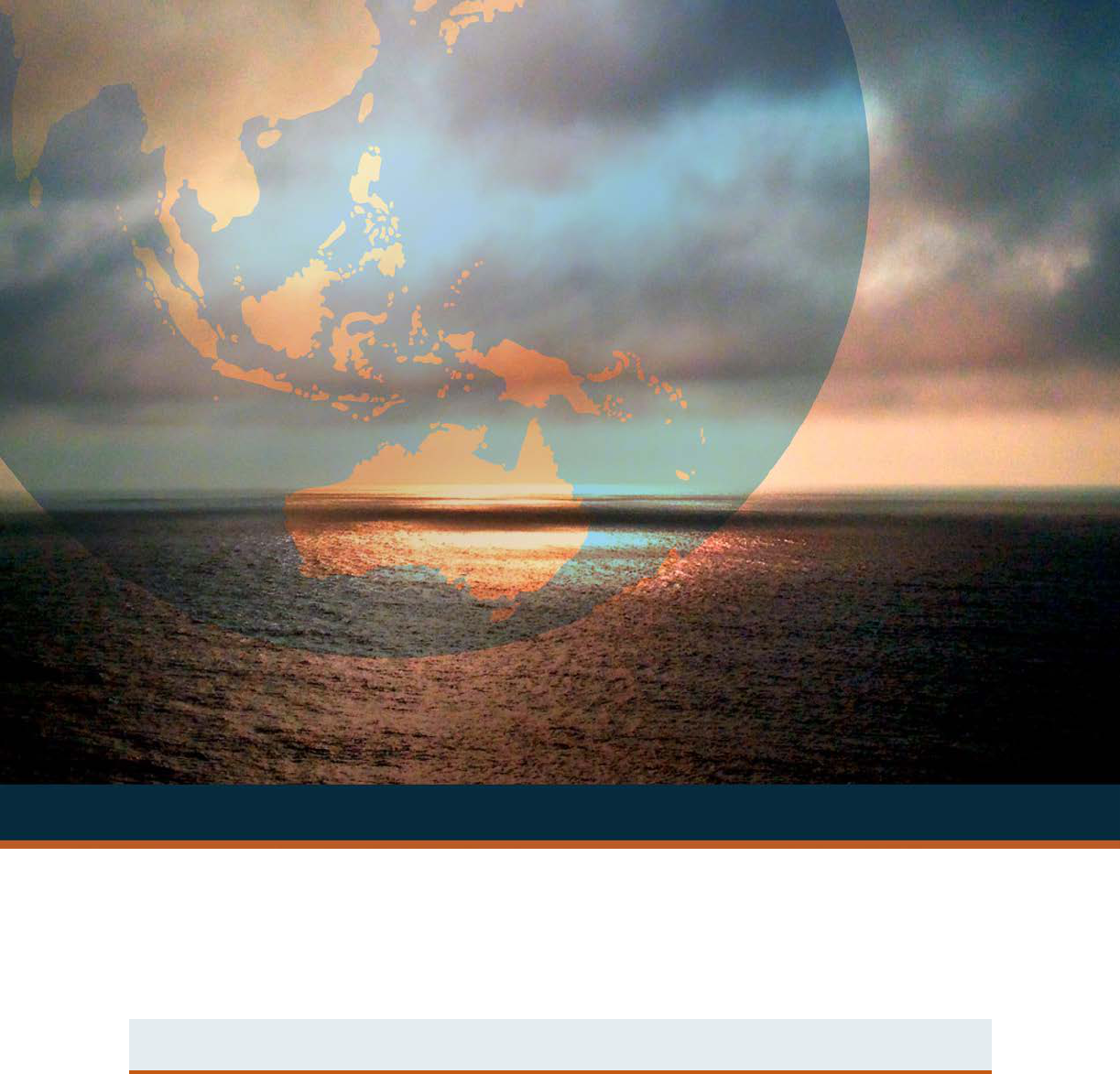
Indo- Pacific Strategy Report
17
4. Sustaining U.S. Influence to
Achieve Regional Objectives
he National Defense Strategy directs the Department to increase lethality, to strengthen alliances,
and to expand the competitive space. In the context of the Department’s Indo-Pacific
Strategy, this translates into the pursuit of
Preparedness, Partnerships, and Promoting a
Networked Region
.
4.1. Line of Effort 1: Preparedness
The National Defense Strategy directs the Department to employ its resources in ways that enhance the
lethality, resilience, agility, and readiness of the Joint Force. This resourcing must span near-term
force employment activities and longer-term investments to modernize and redesign the U.S. military.
The Department is developing innovative capabilities and operating concepts to address specific
operational problems. This also involves identifying new, asymmetric ways to upgrade and employ
legacy systems. Experimentation and exercises to test evolving warfighting concepts and capabilities
help create a virtuous cycle that spurs additional ideas and innovations. Many of these experiments
T

Indo- Pacific Strategy Report
18
and exercises are being conducted alongside allies and partners to ensure we can test and improve
interoperability for joint and combined operations.
The National Defense Strategy implicitly
acknowledges the most stressing potential
scenarios will occur along our competitors’
peripheries. If our competitors decide to
advance their interests through force, they
are likely to enjoy a local military advantage
at the onset of conflict. In a fait accompli
scenario, competitors would seek to employ
their capabilities quickly to achieve limited
objectives and forestall a response from the
United States, and its allies and partners.
DoD initiatives on force employment, crisis
response, force and concept development,
and collaboration with allies and partners
are aimed to help address this critical challenge.
The National Defense Strategy directs the Department to
posture ready, combat-credible forces
forward
–
alongside allies and partners
– and, if necessary, to fight and win. This approach
intentionally presents competitors with a dilemma by ensuring they cannot quickly, cheaply, or easily
advance their aims through military force.
Competitors are compelled to advance
their interests through other, more benign
means – which are often subject to
internationally recognized rules or widely-
accepted state practices.
The Department is undertaking a range of
efforts to enhance Joint Force
preparedness for the most pressing
scenarios. Examples of DoD initiatives
include:
Investments in Advanced Training Facilities at the Joint Pacific Alaska Range Complex to
present a more a realistic and representative training environment;
Investments in unit and depot maintenance across Air Force and Naval Aviation to achieve
an 80 percent fighter readiness goal by the end of Fiscal Year (FY) 2019; and,
Investments in advanced missile defense systems interoperable with allied systems in Japan
and Australia.
“We are adapting to fight against near-peer
competitors. Our armed forces are learning
to expect to be contested throughout the
fight...We are
changing our mindset,
working to regain our advantages, and
playing to our strengths. Alliances and
partnerships are at the heart of this
competitive effort.”
- Assistant Secretary of Defense for Indo-Pacific Security
Affairs, Randall G. Schriver, speech at the Elliot School
of International Affairs, February 7, 2019
“The 2018
National Defense Strategy
’s
unified framework enables a potent
combination of teamwork, resources, and
an unmatched network of a
llies and
partners stepping up to shoulder their
share of the burden for international
security. The
National Defense Strategy
also fosters alignment wit
hin the
Department, the Interagency, industry,
and Congress.”
- Acting Secretary of Defense Shanahan, testimony to the
House Armed Services Committee, March 26, 2019

Indo- Pacific Strategy Report
19
The Department is also modernizing the force to meet the demands of high-end competition.
Illustrative examples of key investments include:
Acceleration of the development and forward presence of U.S. land forces’ Multi-Domain
Task Force, utilizing Security Force Assistance Brigades to build partner capacity and
strengthen multinational teams, and expanding Pacific Pathways to deepen relationships with
U.S. allies and partners;
Strategic deterrence enhancements associated with investments in the new Columbia-class
ballistic missile submarine;
Purchase of 110 4th- and 5th-generation aircraft which will result in both capability and
capacity improvements;
Purchase of approximately 400 Advanced Medium-Range Air-to-Air Missiles;
Purchase of more than 400 Joint Air-Surface Missiles – Extended Range;
Investments in two Unmanned Surface Vehicles, additional Long Range Anti-Ship Missiles,
and additional Maritime Strike Tactical Tomahawks;
Increased capacity in Anti-Surface Warfare, Anti-Submarine Warfare, and Ballistic Missile
Defense (BMD) by purchasing 10 more destroyers within the FY 2020-2024 Future Years
Defense Program;
Investment in resources to support offensive and defensive cyberspace operations; and,
Efforts to unify, focus, and accelerate the development of space doctrine, capabilities, and
expertise to outpace future threats, institutionalize advocacy of space priorities, and further
build space warfighting culture.
Current Posture in the Indo-Pacific
Defense posture is a visible manifestation of U.S. national interests and priorities abroad, and makes
up the network of U.S. forces and capabilities that are forward-deployed in the region, as well as the
interconnected bases, infrastructure, installations, and international agreements that support both day-
to-day and wartime employment of the force.
In the region, USINDOPACOM currently has more than 2,000 aircraft; 200 ships and submarines;
and more than 370,000 Soldiers, Sailors, Marines, Airmen, DoD civilians, and contractors assigned
within its area of responsibility. The largest concentration of forces in the region are in Japan and the
ROK. A sizable contingent of forces (more than 5,000 on a day-to-day basis) are also based in the
U.S. territory of Guam, which serves as a strategic hub supporting crucial operations and logistics for
all U.S. forces operating in the Indo-Pacific region. Other allies and partners that routinely host U.S.
forces on a smaller scale include the Philippines, Australia, Singapore, and the United Kingdom
through the island of Diego Garcia.

Indo- Pacific Strategy Report
20
Future Posture in the Indo-Pacific
To achieve our strategic objectives in the Indo-Pacific, we seek to evolve our posture and balance key
capabilities across South Asia, Southeast Asia, and Oceania to have a more dynamic and distributed
presence and access locations across the region. For example, as announced by Vice President Pence
on November 16, 2018, the United States seeks to partner with Papua New Guinea and Australia on
their joint initiative at Lombrum Naval Base on Manus Island.
In order to overcome the tyranny of distance, posture that supports and enables inter- and intra-
theater logistics must be flexible and resilient, and the pre-positioning of equipment is critical.
Specifically, we are exploring expeditionary capabilities; dynamic basing of maritime and air forces;
special operations forces capable of irregular and unconventional warfare; anti-submarine capabilities;
cyber and space teams equipped for multi-domain operations; and, unique intelligence, surveillance,
and reconnaissance (ISR) capabilities – among other investments. From leveraging existing access in
the Compact States, to pursuing co-development with our most capable allies and partners, we will
continue to forward-station leading edge technologies, such as 5th generation fighters in the Indo-
Pacific.
DoD is also developing new operating
concepts to increase our lethality, agility, and
resilience that will be further implemented
through our evolving posture. For example,
as part of the Multi-Domain Operations
concept, the U.S. Army will test Multi-
Domain Task Forces intended to create
temporary windows of superiority across
multiple domains, and allow the Joint Force
to seize, retain, and exploit the initiative. The
U.S. Army will test the Multi-Domain Task Forces through the Pacific Pathways program to determine
the right capability mix and locations. Furthermore, the Expeditionary Advanced Base Operations is
an emerging U.S. Navy and Marine Corps operating concept to provide resilience and support to
maritime operations inside contested environments. It is intended to deny adversary freedom of
action; control key maritime terrain; and support Joint Force air and maritime requirements by
operating from austere locations at a tempo that complicates adversary targeting.
In addition, DoD will continue to ensure a force posture that enables the United States to undertake
a spectrum of missions including security cooperation, building partner capacity, collaboration on
transnational threats, and joint and combined training.
“DoD’s participation in combined
military exercises has increased by
seventeen percent in the last two years,
and our Foreign Military Sales have
increased by more than sixty-five percent
in the last three years.”
- Acting Secretary of Defense Shanahan, testimony to the
House Armed Services Committee, March 26, 2019

Indo- Pacific Strategy Report
21
4.2. Line of Effort 2: Partnerships
U.S. engagement in the Indo-Pacific is rooted in our long-standing security alliances – the bedrock on
which our strategy rests. Mutually beneficial alliances and partnerships are crucial to our strategy,
providing a durable, asymmetric strategic advantage that no competitor or rival can match.
Expanding our interoperability with allies and partners will ensure that our respective defense
enterprises can work together effectively during day-to-day competition, crisis, and conflict. Through
focused security cooperation, information-
sharing agreements, and regular exercises, we
are connecting intent, resources, and
outcomes and building closer relationships
between our militaries and economies.
Increasing interoperability also involves
ensuring our military hardware and software
are able to integrate more easily with those of
our closest allies and partners, offering financing and sales of cutting-edge U.S. defense equipment to
security partners, and opening up the aperture of U.S. professional military education to more Indo-
Pacific military officers.
To this end, we have strengthened our alliances
with Japan, South Korea, Australia, the
Philippines, and Thailand. These alliances are
indispensable to peace and security in the region
and our investments in them will continue to pay
dividends for the United States and the world,
far into the future. We have also taken steps to
expand partnerships with Singapore, Taiwan,
New Zealand, and Mongolia. Within South
Asia, we are working to operationalize our Major
Defense Partnership with India, while pursuing
emerging partnerships with Sri Lanka, the
Maldives, Bangladesh, and Nepal. We are also
continuing to strengthen security relationships
with partners in Southeast Asia, including
Vietnam, Indonesia, and Malaysia, and
sustaining engagements with Brunei, Laos, and
Cambodia. In the Pacific Islands, we are enhancing our engagement to preserve a free and open Indo-
Pacific, maintain access, and promote our status as a security partner of choice. Efforts to maintain a
free and open Indo-Pacific have also brought us closer to key allies, including the United Kingdom,
France, and Canada, each with their own Pacific identities.
“Our network of allies and
partners is a force multiplier for
peace and interoperability.”
- 2018 National Defense Strategy
BURDEN SHARING
The National Security Strategy calls on the
United States to pursue cooperation and
reciprocity together with our allies,
partners, and aspiring partners.
Cooperation means sharing responsibilities
and burdens. The United States expects
our allies and partners to shoulder a fair
share of the burden of responsibility to
protect against common threats. When we
pool resources and share responsibility for
our common defense, our security burden
becomes lighter and more cost-effective.

Indo- Pacific Strategy Report
22
Modernizing Alliances
JAPAN
The U.S.-Japan Alliance is the cornerstone of peace and prosperity in the Indo-Pacific, with the United
States remaining steadfast in its commitment to defend Japan and its administered territories. As the
security dynamic in the Indo-Pacific evolves, however, it is imperative that the U.S.-Japan Alliance
adapt to meet the challenges that
threaten our security and shared
values. Whether countering
North Korea’s rogue behavior, or
long-term strategic competition
with China and Russia, we must
pursue concrete objectives that
preserve the alliance as our
asymmetric advantage.
The National Defense Strategy clearly
articulates that the Department
will prioritize and strengthen our
alliances, identifying the U.S.-
Japan Alliance as a critical
relationship. Japan’s 2018 National Defense Program Guidelines echoes a similar message, reinforcing
the fundamental fact that the security interests of both the United States and Japan are closely
intertwined. Given the urgency to address new threats, trends, and technologies, we have already seen
progress in operational
cooperation, mutual asset
protection, and bilateral planning.
Maintaining the technological
advantage the alliance needs to
fight and win against our
adversaries is also a top-tier
priority, with the Department
continuing to streamline Foreign
Military Sales (FMS) to Japan and
other allies, pursue co-
development opportunities, and
deepen cooperation in the cyber
and space domains.
FOREIGN MILITARY SALES
The National Security and National Defense Strategies have
elevated FMS as a tool of first resort in strengthening
alliances and attracting new partners. Conventional Arms
Transfer Policy and Security Cooperation reforms have
focused our ability to improve the efficiency and
effectiveness of FMS. We have been successful in
reducing costs, improving processing times, and
minimizing policy hurdles to make technology more
available to a larger group of partners.
Acting Secretary
Shanahan with
Japanese Minister
of Defense
Takeshi Iwaya, at
the Pentagon,
January 16, 2019.
Photo by Master Sgt. Angelita
Lawrence

Indo- Pacific Strategy Report
23
POSTURE: JAPAN
U.S. forces in Japan are an essential component of our posture in the region. To meet shared threats,
advance common interests, and fulfill our obligations under the U.S.-Japan Treaty of Mutual
Cooperation and Security – a key enabler for maintaining a free and open Indo-Pacific region – the
Department remains steadfast in its commitment to deploy our most capable and advanced forces to
Japan. The Government of Japan
contributes financially to the
stationing of U.S. forces in Japan
through a Special Measures
Agreement. This strategic
contribution directly supports the
operational readiness of U.S. forces
in Japan.
The Department assigns
approximately 54,000 military
personnel to Japan, in the U.S.
Navy’s Seventh Fleet, U.S. Marine
Corps’ III Marine Expeditionary
Force, 3 Air Force wings, and
smaller U.S. Army and Special
Operations units. Some of the more
advanced capabilities stationed in
Japan include the F-35, MV and
CV-22, and the USS RONALD
REAGAN, our only forward
deployed aircraft carrier. BMD
assets are also tightly woven into our
force posture in Japan, including
AEGIS Destroyers, sophisticated
BMD radar systems, and a
PATRIOT firing unit to counter the
ballistic missile threat. Enhancing
operational cooperation between
the U.S. forces and Japan Self
Defense Forces (JSDF) is also a
priority, as outlined in the 2015
Guidelines for U.S.-Japan Defense
Cooperation. Bilateral presence
operations throughout the Indo-
Pacific region, mutual asset
GUAM AND THE COMMONWEALTH OF
THE NORTHERN MARIANA ISLANDS
(CNMI)
The Department is modernizing its force posture in
Guam, in keeping with Guam’s position as the
westernmost territory of the United States and a strategic
hub for our joint military presence in the region. We are
establishing a Marine Air Ground Task Force of 5,000
U.S. Marines in Guam starting in the first half of the
2020s as a central feature of the U.S.-Japan realignment
plan. In Guam, we have some of the most significant
ammunition and fuel storage capabilities in the Indo-
Pacific. The addition of rotational maritime lift in Guam
will increase the reach of our combat power in the
Western Pacific. At Anderson Air Force Base, we have
established an active Army Missile Defense capability in
response to increasing threats, and maintain a continuous
bomber presence and ISR capability. In the CNMI we
have air, surface, and subsurface training capabilities and
we are taking steps to ensure we will have ready joint
forces and opportunities for increased multilateral
training.
The Government of Japan has already provided more
than $2 billion of a $3.1 billion commitment for
construction of facilities for the U.S. Marine Corps
realignment. The U.S. Government will fund the balance
of construction, estimated at $8.6 billion, and is working
toward an outcome that enhances our Indo-Pacific
posture, bolsters our security commitments in the region,
and directly benefits Guam.

Indo- Pacific Strategy Report
24
protection missions, and bilateral exercises are just a few areas of operational cooperation that U.S.
forces and the JSDF collaborate on to advance our shared objectives.
The realignment of U.S. forces in Japan contributes to a regional force posture that is geographically
distributed, operationally resilient, and politically sustainable. We have already made substantial
progress on this initiative. Examples include the movement of the U.S. Navy’s Carrier Air Wing Five
to Marine Corps Air Station Iwakuni, the stationing of JSDF units on U.S. Air Force and Army bases,
and the return of more than 10,000 acres of land in Okinawa to the Government of Japan. Future
steps include the completion of the Futenma Replacement Facility and the return of U.S. Marine
Corps Air Station Futenma, as well as the consolidation of our remaining bases and the return of
additional land in Okinawa, Japan.
REPUBLIC OF KOREA
The United States remains steadfast in its
commitment to the defense of the
Republic of Korea (ROK). The U.S.-
ROK Alliance is the linchpin of peace and
prosperity in Northeast Asia, as well as the
Korean Peninsula.
The Department is continuing its work
with the ROK Ministry of National
Defense to transition wartime operational
control for Combined Forces Command
(CFC) from a U.S. Commander to a ROK
Commander. To achieve this, the DoD
and the ROK Ministry of National Defense are investing in critical military capabilities to ensure our
combined readiness to meet any threat to the alliance. The United States and the ROK are also
working to enhance alliance capabilities in the fields of space, cyberspace, and missile defense, along
with efforts to counter weapons of mass destruction.
Together, the United States and the ROK are constantly improving our ISR capacity; developing a
robust, tiered BMD; fielding appropriate command and control assets; acquiring necessary inventories
of critical munitions; and enhancing the tools to prevent, deter, and respond to cyber attacks.
The United States and the ROK continue combined training through command post exercises, as well
as field training exercises to ensure the readiness and combat proficiency of combined forces on the
Peninsula and in the region. The Department is also working to revitalize the United Nations
Command, which contributes to peace and stability on the Korean Peninsula through oversight and
maintenance of the 1953 Armistice Agreement.
“The alliance between South Korean and
American forces is ironclad – forged in
blood, shaped over 65 years of combined
military operations and training, and
hardened by the crucible of war. Shared
sacrifice and mutually agreed principles
underpin our alliance and ens
ure it
endures the winds of change.”
- Commander of U.S. Forces Korea, General Robert B.
Abrams, testimony to the Senate Armed Services
Committee, February 12, 2019

Indo- Pacific Strategy Report
25
POSTURE: REPUBLIC OF KOREA
The U.S-ROK combined force – unique among bilateral U.S. military relationships – is a robust
deterrent to aggression on the Korean Peninsula. As we sustain readiness for any conflict, the United
States and the ROK also remain committed to the final, fully verified denuclearization of North Korea
and enduring peace on the Korean Peninsula.
The Department has three
unique commands on the
Korean Peninsula: U.S. Forces
Korea (USFK), the CFC, and
the United Nations Command.
The ROK hosts 28,500 U.S.
service members and their
families to units including the
U.S. Eighth Army and 2nd
Infantry Division, Seventh Air
Force, U.S. Marine Corps
Forces Korea, U.S. Special
Operations Command-Korea,
and Commander, Naval Forces
Korea. Advanced capabilities
stationed in South Korea include two fighter wings of F-16 and A-10 aircraft; a major U.S. Army
prepositioned stockpile; a combat aviation brigade; a field artillery brigade; advanced ISR units; and a
headquarters for the U.S. Army Corps of Engineers. The ROK continues to invest more in its defense
over the past 15 years than it did in decades
before, spending over 2 percent of its gross
domestic product on defense and increasing
foreign military procurements from the United
States, such as the KF-16 and PATRIOT
battery upgrades, AH-64E Apaches, the
F-15K, RQ-4 Global Hawk variants, and the
F-35A Joint Strike Fighter. Seoul also has
future procurement plans for the P-8, advanced
munitions, upgrades to PAC-3 missiles, and
F-16 fighters – all of which will increase
interoperability with the United States.
Significant improvements in U.S. Force posture during 2018 include adding essential munitions, BMD
systems, and pre-positioned wartime stocks. The United States continues to work with the ROK to
create an interoperable BMD architecture that addresses the ballistic missile threat from North Korea.
In 2017, the United States deployed a Terminal High Altitude Area Defense battery to the ROK.
“The force is sufficiently postured to
deter aggression and defeat any
adversary, if necessary. We continue to
train at echelon to maintain the
readiness required to translate a strong
military posture into decisive victory on
short notice.”
- General Abrams, testimony to the Senate Armed
Services Committee, February 12, 2019
Acting Secretary of
Defense Shanahan
hosts the South
Korean Minister of
National Defense
Jeong Kyeong-doo
at the Pentagon,
April 1, 2019.
Photo by Master Sgt. Angelita
Lawrence
Indo- Pacific Strategy Report
26
The United States and the ROK have agreed to a 10th Special Measures Agreement that will enable
the ROK to help offset the cost of stationing U.S. forces on the Korean Peninsula. The Special
Measures Agreement will ensure essential readiness related personnel and activities, including the
contributions of 9,000 South Korean national employees of USFK serving in crucial roles of public
safety, health care, emergency response, and quality-of-life delivery operations.
Our joint efforts in military construction and modernization ensures our forces are postured, prepared,
and properly set for the future. The Land Partnership Plan and the associated Yongsan Relocation
Plan are bilateral agreements that provide the foundation for streamlining USFK’s footprint while
returning facilities and valuable land to the ROK Government for future development. In 2018,
USFK and United Nations Command Headquarters relocated both commands from U.S. Army
Garrison Yongsan to U.S. Army Garrison Humphreys in Pyeongtaek, joining U.S. Eighth Army and
2nd Infantry Division in new state-of-the-art facilities on the largest DoD facility outside of the
continental United States. By consolidating capability in Pyeongtaek, on facilities built mostly with
ROK funds, we maximize our ability to uphold U.S. security commitments, return large portions of
downtown Seoul to the Korean people for economic development, and improve the quality of life for
our Service members and their families. Since 2003, USFK has returned 49 sites to the ROK while
simultaneously moving the majority of our forces and families away from the demilitarized zone and
closer to major air and sea ports.
AUSTRALIA
U.S. and Australian forces have shared the battlefield in every major conflict since the First World
War and celebrated their “First Hundred Years of Mateship” in 2018. For more than a century, we
have conducted joint and coalition operations, training and exercises, intelligence cooperation, and
capability development. The United States and Australia share a commitment to building on the
interoperability of our armed forces, collaborating to ensure the security of the Indo-Pacific region
into the future, and seeking innovative ways to adapt to new threats.
Australia is providing forces in Iraq for the counter-ISIS fight as trainers, force protection, and
advisors. Australia’s significant commitment to a stable and secure Afghanistan is also helping
modernize our alliance through its contribution to the North Atlantic Treaty Organization (NATO)-
led Resolute Support Mission to train, advise, and assist the Afghan National Defense and Security
Forces. Australia is also a key contributor to the UNSCR enforcement operations to bring North
Korea into compliance with its international obligations and serves as a significant partner to the
Philippines in building counter-terrorism capacity.
Both the United States and Australia are strengthening security in the Indo-Pacific through more
deliberate coordination of the policies and priorities underlying regional engagements by promoting
interoperability to address new threats, increasing focus on the Pacific Islands, and leveraging the U.S.-
Australia force posture initiatives and the unique exercising and training opportunities created in the
process.

Indo- Pacific Strategy Report
27
The Department is also partnering with Australia in cyber, space, and defense science and technology
domains. Together, we are building upon our long-established defense intelligence partnership
through the regular exchange of information and assessments – which strengthens our situational
awareness and capability and enhances our ability to operate together in support of regional stability
and the rules-based international order. The United States and Australia intend to explore new models
of development, acquisition, and sustainment and continue to transform our defense organizations
and processes to meet new challenges.
POSTURE: AUSTRALIA
In 2014, the United States and Australia signed the Force Posture Agreement, a 25-year plus agreement
governing our Force Posture Initiatives and providing our forces more opportunities to work
bilaterally, and in trilateral and regional activities, in areas including maritime capacity building and
humanitarian assistance and disaster relief (HA/DR).
There are two Force Posture Initiatives in northern Australia: (1) the Enhanced Air Cooperation,
improving interoperability through longer duration, more sophisticated training; and (2) Marine
Rotational Forces-Darwin, an annual rotational presence of up to 2,500 U.S. Marines. The Force
Posture Initiatives promote a combined capability to respond to crises and contingencies, strengthen
interoperability, and further
engagement with regional
partners.
In 2018, the U.S. Marine
Rotational Forces-Darwin
completed its seventh
rotation, training with
forces from Australia and
12 other regional countries
and deploying as part of
Australia’s Indo-Pacific
Endeavor – a flotilla that
conducted security
cooperation activities in
Southeast Asia and the
Pacific Islands.
In 2019, the Marine
Rotational Forces-Darwin is expected to grow to 2,500 U.S. Marines. Enhanced Aircraft Cooperation
will deepen as well in 2019, with a robust set of activities planned, and deployment of new capabilities
for these engagements.
Australian Defence Force
members with Charlie
Company, 5th Royal
Australian Regiment, fire
squad automatic weapons
during Marine Rotational
Force - Darwin's Exercise
KOOLENDONG at
Mount Bundey Training
Area, Australia,
August 22, 2018.
Photo by
the U.S. Department of Defense

Indo- Pacific Strategy Report
28
THE PHILIPPINES
The 1951 U.S.-Philippines Mutual Defense Treaty provides the foundation for our bilateral security
cooperation, along with the 1998 Visiting Forces Agreement, and 2014 Enhanced Defense
Cooperation Agreement
(EDCA). These foundational
agreements and our longstanding
history enabled U.S. forces to
support the Philippines during its
battles against ISIS-aligned
extremists that captured the city
of Marawi in 2017. U.S. Special
Operations Forces advisors
remain in the country to date and
provide our continued support to
the Armed Forces of the
Philippines.
We have 280 bilateral defense
activities planned with the Philippines in 2019, and the Philippines hosts the most bilateral exercises
in the USINDOPACOM area of responsibility. This robust annual cooperation ensures our forces
maintain a sufficient level of interoperability to respond in times of crisis.
The Department is partnering with the Armed
Forces of the Philippines in its 15-year
modernization plan to upgrade its capabilities
for territorial defense. The main areas of
emphasis are maritime security, ISR, and
aviation. The United States and the Philippines
are also partnering on reconstituting counter-
terrorism forces following the Marawi siege.
In December 2018, then-Secretary James
Mattis, with authority delegated by the
President, returned the Bells of Balangiga to the Philippines. The Bells were seized during the U.S.-
Philippine War in 1901 and are venerated as religious artifacts by the people of the Philippines. In
returning the Bells of Balangiga to the people of the Philippines, the United States cements the tight
bond between our two countries and peoples, which is based on respect and shared sacrifice.
In March 2016, the United States and the Philippines began to implement the EDCA to give our
forces access to key facilities and allow our militaries to work even more closely together. As part of
this implementation, we are supporting the modernization of the Armed Forces of the Philippines
“In returning the Bells of Balangiga to
our ally and friend - the Philippines - we
pick up our generation's responsibility
to deepen the respect between our two
peoples.”
- Then-Secretary of Defense Mattis, F.E.
Warren Air Force Base, Wyoming,
November 15, 2018
The United States officially
returned the Bells of
Balangiga to the
Philippines, December 11,
2018. (Left to right)
Philippines' Defense
Secretary Delfin Lorenzana,
the Executive Secretary of
the Philippines Salvador
Medialdea, U.S. Deputy
Assistant Secretary of
Defense Joseph H. Felter,
and U.S. Ambassador to the
Philippines Sung Kim.
Photo by the U.S. Department of State

Indo- Pacific Strategy Report
29
and strengthening mutual defense. There are five EDCA Agreed Locations arrayed throughout the
archipelago: Antonio Bautista Air Base, Basa Air Base, Fort Magsaysay Military Reservation, Lumbia
Air Base, and Mactan Benito Ebuen Air Base. The first projects under the agreement were completed
in 2018 and an additional 12 projects have been approved for implementation for 2019 and 2020.
These investments provide force posture enhancements, improve our future readiness, and improve
the operational flexibility of the alliance during contingencies.
In March 2019, Secretary of State Pompeo reaffirmed our commitment to the Mutual Defense Treaty,
providing assurances that, “as the South China Sea is part of the Pacific, any armed attack on
Philippine forces, aircraft, or public vessels in the South China Sea will trigger mutual defense
obligations under Article IV of our Mutual Defense Treaty.”
The United States and the Philippines continue to find new ways to meet our shared goals. For
example, at the invitation of the Government of the Philippines, we concluded a bilateral air exercise
at Basa Air Base that incorporated fighter aircraft of the Armed Forces of the Philippines and the U.S.
Air Force.
THAILAND
The United States and Thailand established relations in 1818 and shortly thereafter, Thailand became
an ally after signing the Treaty of Amity and Commerce in 1833. Our deep and longstanding military-
to-military ties with Thailand were formalized in 1954 with the signing of the Southeast Asia Collective
Defense Treaty (Manila Pact), and in 2003 we reaffirmed our commitment to Thailand by designating
it a major non-NATO ally. The 2014
military coup created significant challenges.
As Thailand continues to take steps toward
democracy, DoD looks forward to
strengthening our longstanding defense ties.
Together we are advancing shared goals of
enhancing regional security; confronting
public health challenges; countering
transnational crime; combating trafficking in
persons, wildlife, and narcotics; and assisting
refugees and displaced persons. We
currently hold more than 130 military-to-
military engagements each year, including
the Indo-Pacific’s largest military exercise,
COBRA GOLD.
As a U.S. ally that is both central to ASEAN and positioned between South Asia and Southeast Asia,
Thailand plays a key geostrategic role in the Indo-Pacific region. The access provided to Utapao Royal
Thai Naval Air Station and the associated deep-water port at Sattahip is a critical enabler for U.S. force
MILITARY EXERCISES IN THE
INDO-PACIFIC
The United States holds some 90 named military
exercises in the Indo-Pacific each year, with the
vast majority of these exercises being conducted
jointly or combined with our allies and partners.
These forces and exercises cooperate with
militaries across the region in a range of activities
from real time HA/DR to the full spectrum of
conventional warfare skills to deter our
adversaries.

Indo- Pacific Strategy Report
30
projection. Utapao supports logistics activities and HA/DR operations such as support to efforts
surrounding the 2015 earthquake in Nepal.
The United States currently enjoys information sharing with Thailand enabled by a General Security
of Military Information Agreement, communications security via a Communications and Information
Security Memorandum of Agreement, and logistics sharing via an Acquisition and Cross-Servicing
Agreement. Our future efforts in Thailand will focus on maintaining and enhancing access at
cooperative security locations, expanding the scope and complexity of our current exercises, and
supporting the Royal Thai Armed Forces’ modernization efforts, most notably the Royal Thai Army’s
intent to update its Brigade Combat Team construct centered on the U.S. Stryker vehicle.
Strengthening Partnerships
As democracies in the Indo-Pacific, Singapore, Taiwan, New Zealand, and Mongolia are reliable,
capable, and natural partners of the United States. All four countries contribute to U.S. missions
around the world and are actively taking steps to uphold a free and open international order. The
strength of these relationships is what we hope to replicate in our new and burgeoning relationships
in the Indo-Pacific.
SINGAPORE
Singapore remains a steadfast partner in Southeast Asia with a strong commitment to promote
regional and global stability. Our long-standing defense relationship is underpinned by the 1990
Memorandum of Understanding, the 2005 Strategic Framework Agreement, and the 2015 U.S.-
Singapore Enhanced Defense Cooperation Agreement. In the 2005 Strategic Framework Agreement,
the United States designated Singapore a “Major Security Cooperation Partner.” Singapore provides
access to U.S. Navy ships, as well as U.S. military aircraft, including most recently littoral combat ships
and P-8 Poseidon aircraft, whose presence has contributed to the security and stability of Southeast
Asia, and continues to ensure a free and open Indo-Pacific.
The Department has long hosted training detachments of fighter aircraft from Singapore to train
alongside the U.S. Air Force in the United States, which helps to further deepen our security ties and
boost interoperability. Singapore annually sends approximately 1,000 personnel to training and
education courses in the United States, representing the largest training presence in the United States
from any foreign military.
Singapore was the first and only Asian country to contribute assets and personnel to the Global
Coalition to Defeat ISIS, and has participated in Operation Gallant Phoenix since May 2017.
Singapore has commanded Combined Task Force 151 in the Gulf of Aden five times.

Indo- Pacific Strategy Report
31
TAIWAN
The United States has a vital interest in upholding the
rules-based international order, which includes a
strong, prosperous, and democratic Taiwan. The
United States is pursuing a strong partnership with
Taiwan and will faithfully implement the Taiwan
Relations Act, as part of a broader commitment to the
security and stability of the Indo-Pacific. Our
partnership is vital given China’s continued pressure
campaign against Taiwan. Taiwan lost three diplomatic partners in 2018, and some international fora
continued to deny the participation of representatives from Taiwan. Although China advocates for
peaceful unification with Taiwan, China has never renounced the use of military force, and continues
to develop and deploy advanced military capabilities needed for a potential military campaign.
The salience of defense engagements has increased as the PLA continues to prepare for contingencies
in the Taiwan Strait to deter, and if necessary, compel Taiwan to abandon moves toward
independence. The PLA is also preparing for a contingency to unify Taiwan with the mainland by
force, while simultaneously deterring, delaying, or denying any third-party intervention on Taiwan’s
behalf. As part of a comprehensive campaign to pressure Taiwan, China has increased military
exercises in the vicinity of Taiwan, including circumnavigation flights by the PLA Air Force and naval
exercises in the East China Sea.
The objective of our defense engagement with Taiwan
is to ensure that Taiwan remains secure, confident, free
from coercion, and able to peacefully and productively
engage the mainland on its own terms. The
Department is committed to providing Taiwan with
defense articles and services in such quantity as may be
necessary to enable Taiwan to maintain a sufficient
self-defense capability. DoD is continually engaged in
evaluating Taiwan’s defense needs to assist Taiwan in
identifying capabilities that are mobile, survivable, and
effective in resisting the use of force or other forms of coercion. Since 2008, U.S. Administrations
have notified Congress of more than $22 billion in FMS for Taiwan.
NEW ZEALAND
Since the Washington Declaration in 2012, the United States and New Zealand continue to deepen
and broaden their defense relationship. The U.S.-New Zealand defense partnership will remain
focused on building maritime security presence, capabilities, and awareness; cooperation to develop
expeditionary defense capabilities; and sharing information to enable security cooperation and to
“America will always believe that
Taiwan’s embrace of democracy
shows a better path for all the
Chinese people.”
- Vice President Pence, remarks at the
Hudson Institute, October 4, 2018
“A strong and secure Taiwan can
deter aggression, defend the
Taiwan people and their hard-
won democracy, and engage on
its own terms with the PRC.”
- Assistant Secretary of Defense for Indo-
Pacific Security Affairs Randall G. Schriver,
remarks at Stanford University, April 10, 2019
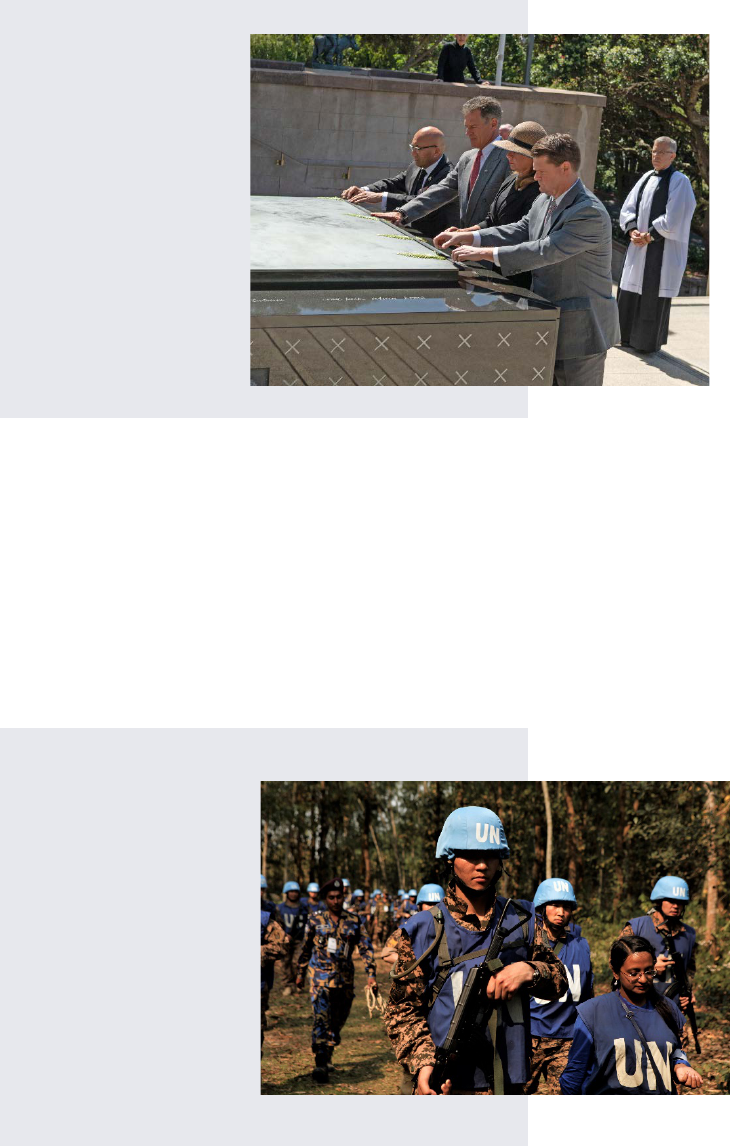
Indo- Pacific Strategy Report
32
prepare to respond to a range of contingencies. New Zealand contributes forces to coalition
operations in Iraq and Afghanistan, to three United Nations peacekeeping missions, and to UNSCR
enforcement operations.
Besides these global contributions,
New Zealand plays a critical role as a
regional leader promoting stability,
building capacity, and responding to
crises and contingencies in the Pacific
Islands, such as natural disasters. In
2018, New Zealand announced the
“Pacific Reset,” its new whole-of-
government policy to engage in the
Pacific Islands, building capacity and
resilience in response to a range of
threats. By collectively stepping up in
partnership with Pacific Island nations
and other likeminded allies and
partners, New Zealand’s Pacific Reset
directly complements DoD’s efforts in the Indo-Pacific and our efforts to renew engagement in the
Pacific. The overlap in our respective strategies creates synergies, as we collectively step up to pool
our resources and respond to the Pacific’s need for greater investment, infrastructure, and capacity
building efforts that match the region’s highest-priority needs.
MONGOLIA
Since the inception of formal bilateral defense cooperation in 1996, the U.S.-Mongolia defense
relationship has developed significantly. Mongolia regards the United States as its most important
“third neighbor” and primary
security partner. The United States
and Mongolia have a
comprehensive partnership based
on common values and shared
strategic interests in protecting and
promoting freedom, democracy,
economic openness, and human
rights worldwide. Mongolia
remains regionally and globally
engaged as a net security exporter
through the Mongolian Armed
Forces’ contributions to the United
Nations peacekeeping operations in
On December 10, 2018,
the U.S. Memorial for
Pukeahu was unveiled
in the presence of the
Minister of Defence
Ron Mark, U.S.
Ambassador to New
Zealand Scott Brown,
and Randall G.
Schriver, Assistant
Secretary of Defense
for Indo-Pacific
Security Affairs.
Photo by the U.S. Department of State
U.N. Peacekeepers
from Mongolia
patrol as part of a
field training
exercise during
Exercise SHANTI
DOOT 4 in
Bangladesh,
March 6, 2018.
Photo by Lance Cpl. Adam
Montera

Indo- Pacific Strategy Report
33
Africa, and its continued deployment in Afghanistan to support coalition operations. Moreover,
Mongolia continues to enforce U.N. Security Council sanctions that have been unanimously adopted
in response to North Korea’s unlawful nuclear and ballistic missile programs. The United States
supports Mongolia's efforts to maintain and further develop a modern, professional, and self-
sustaining military capable of serving as a fully integrated coalition and U.N. Peacekeeping partner.
The United States also assists Mongolia with expanding its capacity to respond to domestic and
regional disasters and humanitarian crises. The United States and Mongolia share a vision for a free
and open Indo-Pacific that safeguards sovereignty and freedom from coercion for all countries.
Mongolia’s regional cooperation and support for multilateral institutions contributes to peace,
stability, and prosperity in the Indo-Pacific and serves as a stabilizing influence in the region.
Expanding Partnerships in the Indian Ocean Region
The United States and India share a
common outlook on the Indo-Pacific. Both
countries recognize the importance of the
Indo-Pacific to global trade and commerce
and acknowledge that developments in this
region will shape the larger trajectory of the
rules-based international order. India,
through its “Act East” policy, continues to
make significant security, economic, and
development investments to secure the
vision of a free and open Indo-Pacific
region. The Indian Ocean Region is at the nexus of global trade and commerce, with nearly half of
the world’s 90,000 commercial vessels and two thirds of global oil trade traveling through its sea lanes.
The region boasts some of the fastest-growing economies on Earth, and is home to a quarter of the
world’s population. While the region offers unprecedented opportunity, it is also confronting a myriad
of security challenges, including terrorism, transnational crime, trafficking-in-persons, and illicit drugs.
To combat these challenges, the United States seeks opportunities to broaden and strengthen
partnerships with India, Sri Lanka, the Maldives, Bangladesh, and Nepal to respond to shared regional
challenges.
INDIA
The United States and India maintain a broad-based strategic partnership, underpinned by shared
interests, democratic values, and strong people-to-people ties. The U.S.-India strategic partnership
has strengthened significantly during the past two decades, based on a convergence of strategic
interests, and the United States and India continue to use their deepening relationship to build new
partnerships within and beyond the Indo-Pacific.
“To advance our vision of a free and open
Indo-
Pacific, we are building new and
stronger bonds with nations that share
our values across the region, from India to
Samoa. Our relationships will flow from a
spirit of respect built on partnership, not
domination.”
- Vice President Pence, remarks at the
Hudson Institute, October 4, 2018
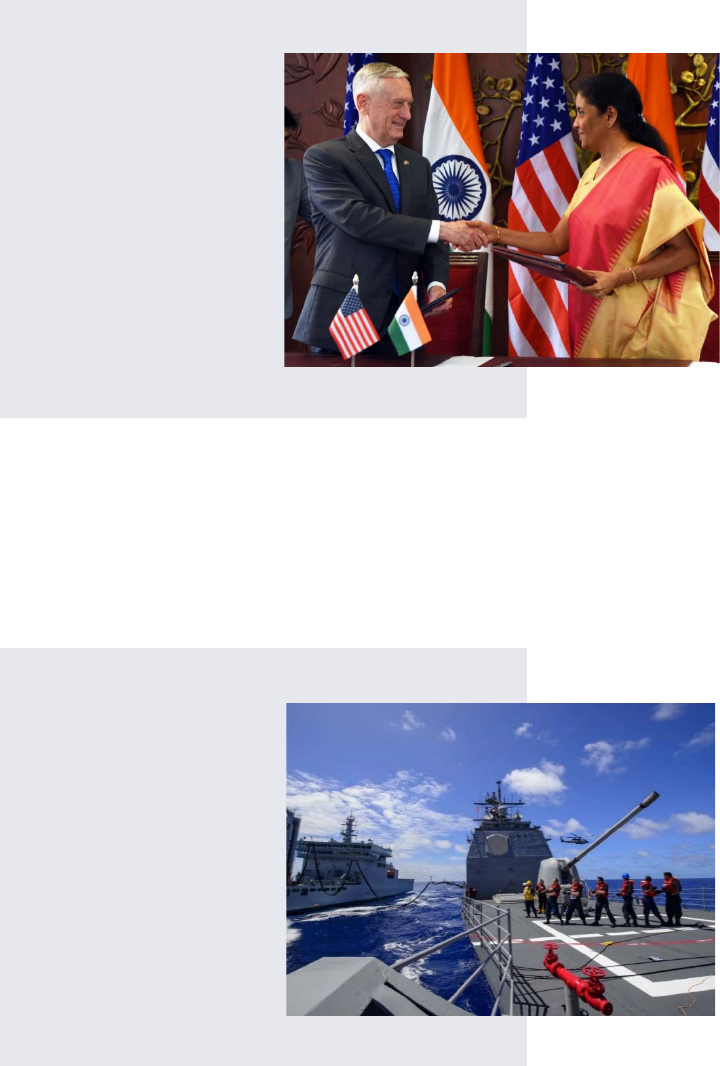
Indo- Pacific Strategy Report
34
In June 2016, the United States
designated India a “Major Defense
Partner,” a status unique to India.
The designation seeks to elevate the
U.S. defense partnership with India
to a level commensurate with that of
the United States’ closest allies and
partners. The establishment of the
U.S.-India 2+2 Ministerial Dialogue
in September 2018 also serves as a
tangible demonstration of our
commitment to promoting the
shared principles of a free and open
Indo-Pacific.
The United States continues to pursue a range of initiatives with India to enable cooperation,
strengthen our interoperability, and establish a strong foundation for defense trade, technology
sharing, industrial collaboration, and broader cooperation on defense innovation. The signing of the
Communications, Compatibility and Security Agreement in 2018 represents a significant development
in our military-to-military relationship, facilitating greater interoperability and real-time secure
information-sharing. DoD and the
Indian Ministry of Defence are
increasing the scope, complexity, and
frequency of our military exercises.
Later this year, the United States and
India will conduct our first tri-service
exercise, and we continue to
collaborate on maritime security and
domain awareness, HA/DR, counter-
piracy, counter-terrorism, and other
transnational issues.
As our shared interests and security
cooperation have expanded, U.S.-
India bilateral defense trade and
technology cooperation have also
grown, with approximately $16 billion in defense trade since 2008. Through the Defense Technology
and Trade Initiative, we are increasing cooperation in defense technology, building industry-to-
industry ties, and identifying opportunities for the co-development and co-production of defense
systems for the sustainment and modernization of military forces.
Then-U.S. Secretary of
Defense Mattis with
the Indian Minister of
Defence Nirmala
Sitharaman during the
signing of the
Communications,
Compatibility and
Security Agreement,
September 6, 2019.
Photo by Petty Officer 2nd Class
Lisa Ferdinando
During MALABAR 2018,
an Indian Navy oiler
conducts an underway
replenishment training
exercise with a U.S.
warship, enabled by the
implementation of the
U.S.-India Logistics
Exchange
Memorandum of
Agreement.
Photo by Mass Communication
Specialist 2nd Class William McCann

Indo- Pacific Strategy Report
35
SRI LANKA
Since 2015, DoD has strengthened its relationship with Sri Lanka and increased military engagements
significantly, particularly with the Sri Lankan Navy. In 2017, we conducted the first port visit in 30
years by a U.S. aircraft carrier – the USS NIMITZ Carrier Strike Group – and the first ever bilateral
Cooperation Afloat Readiness and Training (CARAT) Exercise. In 2019, we increased cooperation
on mutual logistics arrangements in support of Indian Ocean security and disaster response.
THE MALDIVES
Following the recent democratic transition in the Maldives, the United States has begun to explore
avenues to expand security cooperation, with particular emphasis on providing capacity-building
opportunities to the Maldives National Defence Forces and Maldivian Coast Guard. Key areas of
focus include: maritime domain awareness (MDA) – to enable Maldivian forces the ability to monitor
and patrol its sovereign maritime area and contribute to regional efforts to protect sea lines of
communication; HA/DR readiness; and counter-terrorism capability. An additional $7 million in FY
2018 Foreign Military Financing (FMF) will support these efforts.
BANGLADESH
The United States enjoys a strong defense relationship with Bangladesh, an important partner for
regional stability and security. Security cooperation focuses on key areas such as maritime security
and domain awareness, counter-
terrorism, HA/DR,
peacekeeping, and border
security. The annual Bilateral
Defense Dialogue between
USINDOPACOM and the
Bangladesh Armed Forces
Division sets the strategic
direction of our defense
relationship. In addition, recent
increases in FMF, International
Military Education and Training
(IMET), and the inclusion of
Bangladesh in the Maritime
Security Initiative (MSI)
underscores not only the value the United States places on its defense partnership with Bangladesh,
but also Dhaka’s contributions towards regional stability in support of upholding a rules-based
international order in South Asia and the Indian Ocean Region.
United States and
Bangladesh naval
officers pilot a P-8
during the CARAT
Exercise in 2018.
Photo by Petty Officer 3
rd
Class
Tristin Barth
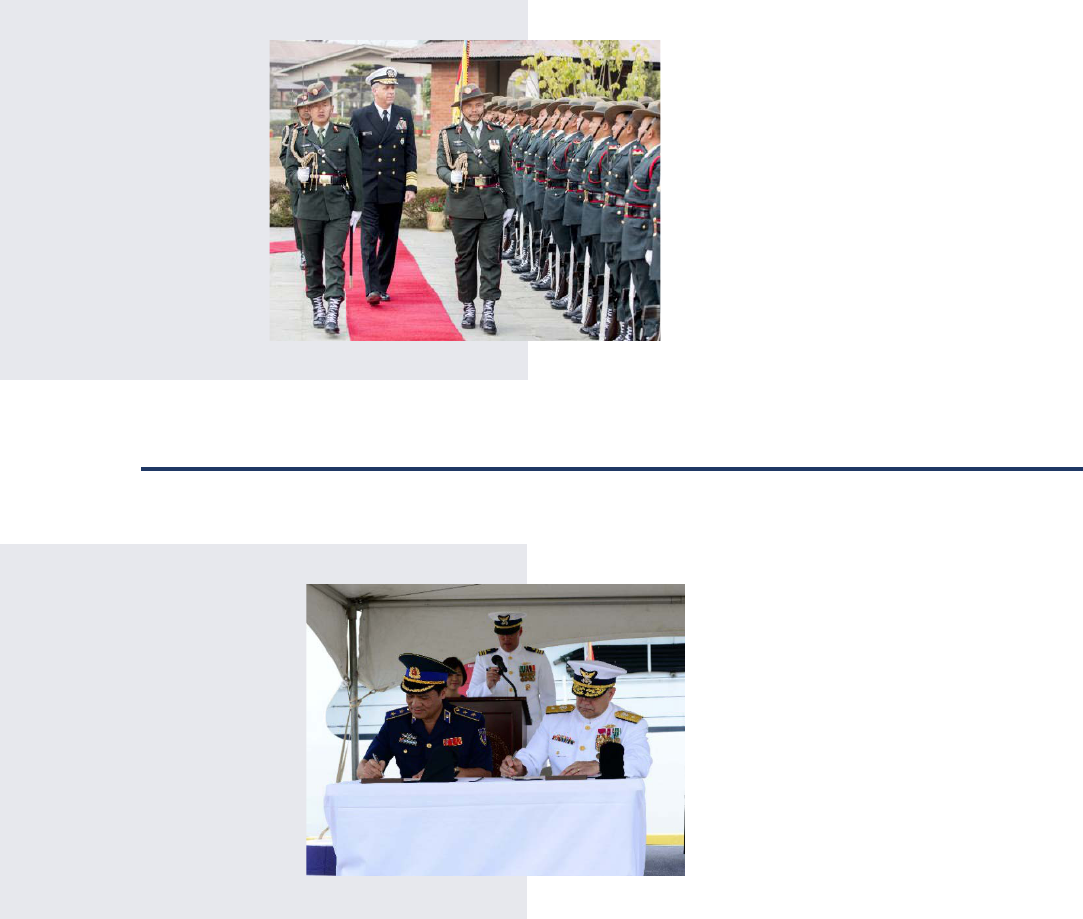
Indo- Pacific Strategy Report
36
NEPAL
The United States seeks to expand our
defense relationship with Nepal, focused on
HA/DR, peacekeeping operations, defense
professionalization, ground force capacity,
and counter-terrorism. Our growing
defense partnership can be seen in the
establishment of the U.S. Army Pacific-led
Land Forces Talks in June 2018, our senior-
most military dialogue with Nepal. This
year has already seen several senior-level
visits to Nepal by the USINDOPACOM
Commander and Deputy Assistant
Secretary of Defense for South and
Southeast Asia to further advance our defense relationship.
Expanding Partnerships in Southeast Asia
Through the implementation of the
National Defense Strategy in the Indo-
Pacific, the United States is prioritizing
new relationships with Vietnam,
Indonesia, and Malaysia – key players in
ASEAN that remain central in our
efforts to ensure peace and underwrite
prosperity in the Indo-Pacific. All three
countries represent engines of economic
growth that are strategically located on
key sea lanes between the Indian and
Pacific Oceans. While maintaining
independent foreign policies, Vietnam,
Indonesia, and Malaysia are aligned with the region’s shared vision for a free and open Indo-Pacific
and are focused on maintaining peace, stability, and prosperous economic development in the region.
VIETNAM
The Department is building a strategic partnership with Vietnam that is based on common interests
and principles, including freedom of navigation, respect for a rules-based order in accordance with
international law, and recognition of national sovereignty. The U.S.-Vietnam defense relationship has
Commander of the U.S.
Indo-Pacific Command
Admiral Phil Davidson
visits Nepal,
January 11, 2019.
Photo by Petty Officer 1st Class Robin
Peak
After nearly 50 years of
service in the U.S. Coast
Guard, the Hamilton-class
cutter (WHEC-722) was
officially transferred to the
Vietnam Coast Guard
under the name CSB-8020.
A transfer ceremony took
place at Coast Guard Base,
Honolulu, May 25, 2017.
Photo by Petty Officer 2nd Class Melissa
McKenzie
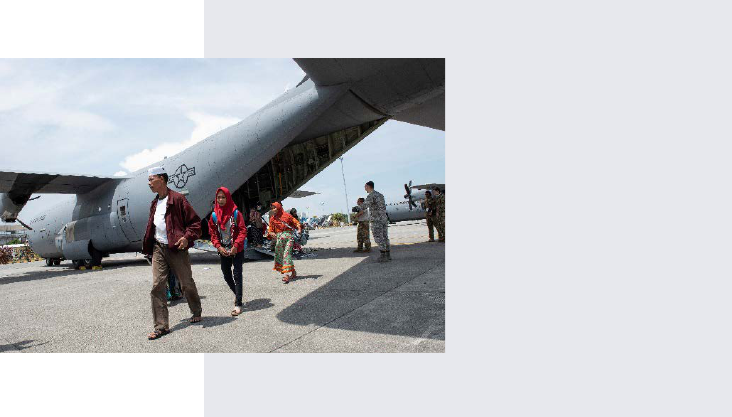
Indo- Pacific Strategy Report
37
grown dramatically over the past several years, as symbolized by the historic March 2018 visit of a
U.S. aircraft carrier for the first time since the Vietnam War.
The Department is working to improve Vietnam’s defense capabilities by providing security assistance,
including Scan Eagle Unmanned Aerial Vehicles, T-6 trainer aircraft, a former U.S. Coast Guard high-
endurance cutter, and small patrol boats and their associated training and maintenance facilities. The
U.S. military also engages in numerous annual training exchanges and activities to enhance bilateral
cooperation and interoperability with the Vietnam People’s Army, Air Force, Navy, and Coast Guard.
Additionally, DoD has provided training and technical assistance to support Vietnam’s 2018
deployment of a medical unit to the U.N. Peacekeeping Mission in South Sudan, and will continue to
provide assistance to facilitate future deployments.
Our increasingly strong defense ties are based on a foundation of close cooperation to address legacy
of war and humanitarian issues, which predates the restoration of diplomatic relations in 1995. As we
look to celebrate 25 years of diplomatic relations in 2020, DoD remains committed to supporting U.S.
efforts to clean up dioxin contamination and remove unexploded ordnance, and appreciates Vietnam’s
continued assistance to account for U.S. personnel missing from the Vietnam War.
INDONESIA
As the world’s second and third
largest democracies, the United
States and Indonesia share many
common strategic interests, and this
year celebrate 70 years of diplomatic
relations. The United States
supports Indonesia’s vision to
become a “global maritime
fulcrum” straddling the Indian and
Pacific Oceans. Indonesia and the
United States cooperate on defense
issues under the auspices of the
U.S.-Indonesia Comprehensive
Partnership, reaffirmed in October 2015. The Strategic Partnership focuses on six areas for advancing
defense cooperation: maritime security and domain awareness; defense procurement and joint
research and development; peacekeeping operations and training; professionalization; HA/DR; and
countering transnational threats such as terrorism and piracy.
The United States and Indonesia conduct an active exercise program that enhances our respective
capacity and interoperability based on common platforms such as F-16 fighters and Apache attack
helicopters. Our bilateral defense activities include more than 200 bilateral military engagements a
year, one Joint Staff sponsored exercise, and several service-level maneuver exercises annually.
U.S. Air Force members
escort displaced people off
a U.S. C-130 Hercules
aircraft in Balikpapan,
Indonesia,
October 9, 2018.
Thousands were displaced
after a 7.5 magnitude
earthquake and tsunami
struck Indonesia’s
Sulawesi Island.
Photo by Master Sgt. James May

Indo- Pacific Strategy Report
38
Indonesia is a major recipient of IMET funds in the Indo-Pacific, which are used to enhance the
military professionalization of the Army, Navy, Air Force, and Coast Guard. Future areas of
collaboration include developing defense industry partnerships that will expand coordination on
acquisition, technology transfer, cooperative research, industrial collaboration, and logistics support.
MALAYSIA
Malaysia is a key player in Southeast Asia
and we will continue to deepen our security
and defense cooperation. Our ties have
remained strong for many years, and we are
working with the Pakatan Harapan
Government to further strengthen this
important relationship. Malaysia’s regional
leadership role, technologically advanced
industry, sizeable economy, and capable
military make it an important partner in
securing peace and prosperity in Southeast
Asia. Malaysia has demonstrated the
capacity and resolve to contribute to
regional security, and we continue to
support Malaysia’s emerging security
requirements.
We conduct more than 100 defense
engagements with Malaysia annually,
including exercises, subject matter expert
exchanges, and partner on common
objectives such as maritime security and
counter-terrorism. We improve our
interoperability through combined air,
maritime, and amphibious training in
multiple locations across the country. At sea
we participate in both the CARAT and
Southeast Asia Cooperation and Training
(SEACAT) Exercises and are increasing
cooperation with Malaysia’s maritime law
enforcement agency, in coordination with
the U.S. Department of State. Through the
MSI, we are helping Malaysia improve its
MDA by providing sensors on existing
platforms. We are deploying a U.S.
THE STATE PARTNERSHIP
PROGRAM IN THE INDO-PACIFIC
The State Partnership Program began in 1993
with partnerships between the National Guard
of designated U.S. States and newly
independent Eastern European countries.
The State Partnership Program has since
expanded to other regions, including the
Middle East, Africa, Latin America, Western
Europe, and the Indo-Pacific.
By the end of FY 2019, the United States will
have 79 partnerships with 86 nations, 12 of
which are in the Indo-Pacific:
Bangladesh / Oregon (2008)
Cambodia / Idaho (2009)
Indonesia / Hawaii (2006)
Malaysia / Washington (2017)
Mongolia / Alaska (2003)
Philippines / Hawaii, Guam (2000)
Thailand / Washington (2002)
Tonga and Fiji / Nevada (2014 & 2018)
Vietnam / Oregon (2012)
Recently Added:
Nepal (2019)
Sri Lanka (2019)

Indo- Pacific Strategy Report
39
maritime advisor to Malaysia to improve our partnership and coordination on maritime security and
MDA. Malaysia also actively partners in international counter-terrorism efforts, adding its regional
perspective to support the global effort to defeat ISIS.
Malaysia has been a critical partner of increasing importance in the region ever since the United States
elevated the relationship to a Comprehensive Partnership in 2014. Malaysia is a leader on several key
regional security challenges in Southeast Asia, particularly maritime security and countering violent
extremism. For example, Malaysia participates in multilateral air and maritime patrols in the Malacca
Strait with Indonesia, Singapore, and Thailand, focused on countering threats to international shipping
in that vital waterway. Malaysia also participates in similar patrols in the Sulu and Celebes Seas with
Indonesia and the Philippines aimed at countering violent extremists. The Malaysia Maritime
Enforcement Agency formally committed to host the Southeast Asia Maritime Law Enforcement
Initiative (SEAMLEI) Commanders’ Forum in December 2019. Malaysia plays a leadership role on
HA/DR, and currently co-chairs the ASEAN Defense Ministers’ Meeting Plus (ADMM-Plus)
HA/DR Experts’ Working Group with the United States.
The Malaysian Armed Forces have demonstrated the professionalism, capacity, and resolve to
contribute to regional security and international U.N. missions. We will continue to work closely with
Malaysia to advance these and similar efforts which support a free and open Indo-Pacific.
Sustaining Engagements, Strengthening Foundations
As outlined in the Treaty of Amity and Cooperation in Southeast Asia of 1976, Brunei, Laos, and
Cambodia embrace ASEAN values including, but not limited to, the mutual respect for the
independence, sovereignty, equality, territorial integrity, and national identity of all nations; the right
of every state to lead its national existence free from external interference, subversion, or coercion;
and the settlement of differences or disputes in a peaceful manner. These principles underscore the
importance of the sovereignty of all nations, and are in line with the U.S. vision for a free and open
Indo-Pacific. While the United States maintains measured engagements with Brunei, Laos, and
Cambodia, we continue to seek opportunities to enhance defense relations as conditions permit.
BRUNEI
Military-to-military ties have become a mainstay of the U.S.-Brunei bilateral relationship. The
Bruneian Government has welcomed the growth of military ties with the United States and like-
minded nations, including with respect to enhancing MDA. In 2018, in addition to the Brunei Navy's
participation in the RIM OF THE PACIFIC Exercise and holding our annual bilateral CARAT
Exercise, the Royal Brunei Land Forces and U.S. Army conducted their first bilateral exercise –
PAHLAWAN WARRIOR – in Brunei. This year the United States co-hosted with Brunei a
multilateral Cooperation Against Transnational Threats workshop. We continue to look for ways to
expand our military-to-military cooperation, including through increased information sharing.

Indo- Pacific Strategy Report
40
LAOS
Strategically located in the geographic heart of ASEAN and the Mekong sub-region, Laos presents
opportunities for deepening security, economic, and diplomatic engagement. China is increasingly
focused on Laos, and Beijing continues efforts to expand its strategic footprint through large debt-
fueled investments, especially in infrastructure and energy. However, Laos is wary of overdependence
and is seeking to diversify its partners and
options. At the same time, Laos is
experiencing a significant demographic shift
– with a large majority of its population
under the age of 35 – which presents a
unique opportunity to engage a new,
outward looking generation. The Lao
military prioritizes Vietnam, Russia, and to
a lesser degree China as its primary security
partners. At the same time, the Laotian
military is slowly expanding its international
engagement portfolio, first to ASEAN and
to a lesser degree to countries in the region
such as Japan, Australia, and India.
The United States supports activities that advance Laos’ integration into ASEAN, such as defense
modernization, interoperability, English language proficiency, and respect for a rules-based
international order. In the meantime, we are working to move past war legacy issues related to the
Vietnam War and aim to conclude Prisoner of War/Missing in Action recovery operations honorably,
and by 2030 to make Laos substantially risk-free of U.S.-sourced unexploded ordnance.
CAMBODIA
DoD seeks to build a productive military-to-military relationship with the Kingdom of Cambodia that
protects its sovereignty, promotes military professionalism, and helps it become a responsible and
capable contributor to regional security. In early 2017, Cambodia suspended all military-to-military
exercises with the United States. We, however, continue to cooperate in peacekeeping operations,
humanitarian mine action, medical research, and U.S. Missing in Action personnel accounting.
Revitalized engagements in the Pacific Islands
We are revitalizing our engagement in the Pacific Islands to preserve a free and open Indo-Pacific
region, maintain access, and promote our status as a security partner of choice. The Pacific Islands
represent a region distinct from other regions in the Indo-Pacific because of the relatively small size
of states, unique geography, and challenges to promote economic prosperity. As a Pacific nation itself,
Deputy Assistant
Secretary of
Defense Joseph
H. Felter with a
Lao Unexploded
Ordnance
disposal team at a
cleanup site in
southern Laos,
January 18, 2019.
Photo by the U.S. Department
of Defense

Indo- Pacific Strategy Report
41
the United States views the
Pacific Islands as critical to
the U.S. strategy because of
our shared values, interests,
and commitments,
including U.S. security
guarantees to the Freely
Associated States. Our
shared interests with the
Pacific Islands underscore
four important components
special to this region.
First, we share a long history, born from
commitments and support during the Second
World War that compels a renewed U.S.
commitment to stay. Second, we believe
strongly in respect for a safe, secure, and
prosperous, free and open Indo-Pacific that
must preserve small states’ sovereignty. Third,
we aim to focus on building capacity and
resilience to address maritime security; Illegal,
Unreported, and Unregulated fishing; drug
trafficking; and resilience to address climate
change and disaster response, as signified by the
2018 Boe Declaration. Fourth and finally, we
are committed to continued engagement in the
region, by reaffirming and renewing
partnerships.
Of the Pacific Islands, three have militaries:
Papua New Guinea, Fiji, and Tonga. The
United States works with each to support
improved capability within partner armed
forces and, consistent with a partner-centric
approach, often in support of efforts from allies
and partners such as Australia and New
Zealand.
The United States has a unique relationship with
the Freely Associated States. The Compacts of
Free Association are treaty-like agreements
COAST GUARD PARTNERSHIPS
WITH THE PACIFIC ISLANDS
The U.S. Coast Guard operations within the Pacific
Islands have been steady over the past half century.
The Coast Guard’s presence is permanent and its
partnerships enduring. The Coast Guard provides
unique access, influence, and trust due to its routine
interactions with the Pacific Islands to address
shared maritime safety, security, and governance
challenges.
The U.S. Coast Guard represents
USINDOPACOM at the Pacific Quadrilateral
Defense Coordinating Group, a Pacific
Consortium (the United States, France,
Australia, and New Zealand) that supports
counter-Illegal, Unreported, and Unregulated
fishing enforcement through multilateral and
bilateral operations with 15 Pacific Island
nations, bringing considerable economic and
security benefits to the participant nations.
The U.S. Coast Guard shiprider agreements
allow 11 Pacific Island nations to exercise
sovereignty in their exclusive economic zone
through U.S. Coast Guard and U.S. Navy ship
deployments.
The U.S. Coast Guard partners with the U.S.
Navy on Oceania Maritime Security Initiative
deployments.
U.S. Coast Guard Cutter
Mellon was in Fiji from
January 22-25, 2019, to
exercise the bilateral
Shiprider Agreement
recently signed between
Fiji and the
United States.
Photo by the U.S. Department of Defense

Indo- Pacific Strategy Report
42
which provide security and financial support to the Federated States of Micronesia, the Republic of
the Marshall Islands, and the Republic of Palau. These nations are important and historic U.S. partners
in the Pacific, with deep ties to the United States.
U.S. security support to the Pacific
Islands comes in many other forms as
well. Many Pacific Island countries
participate in various regional exercises
and training events, including
USINDOPACOM’s KOA MOANA
and PACIFIC PATHWAYS Exercises.
We have increased the number of ship
visits and, in turn, shiprider agreements
that we have exercised. We are
increasingly supportive of capacity
building across the Pacific Islands, which
includes at least $7 million in FMF in
2018 to support Papua New Guinea, Fiji, and Tonga. Additionally, the United States is working with
Palau to improve its MDA to enhance Palau's maritime law enforcement capability.
Engagements with Other Allies
THE UNITED KINGDOM, FRANCE, AND CANADA
Allies such as the United Kingdom, France, and
Canada play a critical role in maintaining a free and
open Indo-Pacific. In addition to military
capability and regional presence, these allies
contribute vital support to upholding free and
open principles in the region and globally.
For example, the United Kingdom has increased
deployments and operations in the region since
2017, contributed to the coordinated,
multinational initiatives to enforce
UNSCR sanctions on North Korea, and
performed its first naval operation
aimed at asserting navigational rights
and freedoms in the South China Sea in
2018 with the transit of its frigate
“The U.S. military is active on a
daily basis to safeguard freedom of
navigation and overflight in the
Indo-Pacific,
demonstrating our
commitment to fly, sail and operate
wherever international law allows.”
- Assistant Secretary of Defense Randall G.
Schriver, s
peech at American Enterprise
Institute, August 7, 2018
In FY 2018, the Department
challenged 40 different maritime
claims of 26 claimants. Many of these
excessive claims were challenged
persistently, throughout the year, in
the course of routine, daily operations.
Assistant Secretary
of Defense for Indo-
Pacific Security
Affairs Randall G.
Schriver announces
a new partnership
between the Nevada
National Guard and
Fiji in Suva,
December 14, 2018.
Photo by the U.S. Department of
Defense

Indo- Pacific Strategy Report
43
HMS SUTHERLAND and
amphibious transport HMS ALBION,
followed by the transit of its frigate
HMS ARGYLL in 2019. The United
Kingdom shares our holistic view of
the region as the “Indo-Pacific,” as
well as the importance of
strengthening alliances and
partnerships with countries in the
region.
The United States and France have
restarted the Indo-Pacific Security
Dialogue, and recognized the
significance of the extended
UPHOLDING FREEDOM AND ACCESS TO GLOBAL COMMONS
Throughout our history, the United States has asserted a key national interest in preserving the freedom of the
seas, and has often relied on the U.S. military forces to protect that interest. As President Ronald Reagan said in
releasing the U.S. Oceans Policy in 1983, “we will not acquiesce in unilateral actions of other states designed to
restrict the rights and freedoms of the international community in navigation and overflight.” Today, in places
like the South China Sea, excessive maritime claims are attempts by coastal States to unlawfully restrict the exercise
of freedoms afforded to all seafaring nations to operate in waters beyond territorial limits. The United States will
continue to fly, sail, and operate wherever international law allows, and encourage our allies and partners to do
the same.
Excessive maritime claims inconsistent with international law, if left unchallenged, threaten the international rules-
based order and U.S. interests and those of our regional allies and partners. Freedom of the seas is essential to
ensuring the global mobility of U.S. forces in the event of a crisis and the worldwide security of civilian shipping
on a daily basis. DoD, therefore, is committed to ensuring free and open maritime access, including through
freedom of navigation (FON) assertions (commonly called Freedom of Navigation Operations, or FONOPs), to
protect the stable economic order and to maintain the ability of U.S. forces to respond, as needed. The FON
program is carefully designed to challenge coastal states’ excessive maritime claims while respecting their rights
under international law.
The FON program protects long-standing principles of freedom of navigation for civilian and military vessels
through both diplomatic and operational challenges, refusing to acquiesce to excessive maritime claims wherever
they are made. FONOPs serve to protect the rights, freedoms, and lawful uses of the sea and airspace guaranteed
to all nations under international law. They are not targeted at any particular country, and they have no bearing
on sovereignty disputes over land features. FONOPs are conducted peacefully and impartially, in accordance
with international law. Consequently, U.S. forces routinely challenge excessive maritime claims asserted by allies
and partners, as well as those made by potential adversaries and competitors.
Arleigh
Burke-class
guided-missile
destroyer USS
SPRUANCE
and
Arleigh Burke-class
guided-missile
destroyer USS
PREBLE
conduct
freedom of navigation
operations in the South
China Sea.
Photo by
the U.S. Department of
Defense

Indo- Pacific Strategy Report
44
deployment of the aircraft carrier FNS CHARLES DE GAULLE to the Indo-Pacific in 2019,
accompanied for portions of its deployment by ships from other NATO countries, Australia, and the
United States. France additionally supports UNSCR enforcement and shares our emphasis on
developing a network of strategic partnerships, contributing to the building of a regional security
architecture, and engaging in multilateral dialogue platforms, in its strategy on France and Security in the
Indo-Pacific.
Canada is contributing to UNSCR enforcement, to include providing a maritime patrol aircraft during
summer 2018. A Canadian officer was also appointed the first non-U.S. Deputy Commander of
United Nations Command in 2018. Canada is also expanding defense cooperation with partners in
the region such as Vietnam, with future efforts expected to focus on advancements in personnel
training, U.N. peacekeeping operations, and increased defense industry ties.
4.3. Line of Effort 3:
Promoting a Networked Region
Shared security in the Indo-Pacific
continues to rest on U.S. military presence
and a growing network of alliances and close
partnerships that promote interoperability
and coordination.
As the Indo-Pacific changes, the United
States is augmenting its bilateral
relationships with trilateral and multilateral
arrangements, and encouraging intra-Asian
security relationships for partnerships with
purpose. As articulated in the National
Defense Strategy, DoD will strengthen and
evolve our alliances and partnerships into an
extended network capable of deterring or
decisively acting to meet the shared
challenges of our time. In the Indo-Pacific,
this includes a networked security
architecture capable of deterring aggression,
maintaining stability, and ensuring free
access to common domains.
In a large and interconnected region, especially one with so many strong, capable, and dedicated
players, it is prudent to network and link relationships to produce gains for all. As we weave together
PARTNERSHIPS WITH PURPOSE
An important example of partnerships with
purpose is the Enforcement Coordination Cell
(ECC) in Yokosuka, Japan. Commanded by
USINDOPACOM and executed by U.S.
Seventh Fleet, the United States is working side-
by-side with South Korea, Japan, Australia,
New Zealand, Canada, France, and the United
Kingdom at a single headquarters to enforce the
UNSCR sanctions regime against North Korea
and the illicit transfer of oil and ship-to-ship
transfers in the East China Sea and Korea Bay.
The ECC allows us to work closely with our
allies and partners to manage, coordinate, and
de-conflict our efforts and is an important
facilitator of transparent collaboration between
our allies and partners at sea and in the air.

Indo- Pacific Strategy Report
45
these partnerships with purpose, a networked security architecture – with its shared values, habits of
cooperation, and compatible and complementary capabilities – will form a strong free and open fabric
that knits the region together, preserving sovereignty and regional peace and stability for years to
come. This is a vision the United States has long advanced in the Indo-Pacific, and one we believe
will continue to benefit the region in terms of stability and prosperity.
TRILATERAL PARTNERSHIPS
First, the Department is strongly emphasizing trilateral mechanisms to bring together like-minded
allies and partners to maximize individual contributions to regional peace and security and link
together nations that previously worked with us mostly separately. The region is more secure when
we combine efforts in this way and we will continue to prioritize these important mechanisms.
The ROK, Japan, and the United
States trilateral partnership is critical
to peace and security in the Indo-
Pacific region. Our three
democracies share the common goals
of upholding a rules-based
international order; achieving the
final fully-verified denuclearization of
North Korea; and strengthening the
network of like-minded nations in the
region. Toward these ends, the
ROK-Japan-United States trilateral
defense partnership continues
practical cooperation on UNSCR
enforcement; information sharing; anti-submarine warfare; BMD; mine counter-measure warfare; and
HA/DR efforts. The United States is committed to further strengthening and growing our trilateral
defense cooperation to meet future regional and international challenges.
The United States is also developing its trilateral partnership with Japan and Australia. Together, we
are cooperating in tangible ways to enhance security across the region and increase our interoperability,
in part, by augmenting our exercises and training; increasing information sharing; and building
capabilities. For example, we are taking what would otherwise be separate or bilateral capacity-
building initiatives in Southeast Asia and ensuring that they not only complement one another, but
are also tailored to assist in building up more comprehensively capable partners. This grouping is also
effectively improving our interoperability by trilateralizing and multilateralizing key military exercises,
including COPE NORTH GUAM and SOUTHERN JACKAROO.
The United States, India, and Japan also enjoy a robust trilateral partnership. The annual naval
exercise, MALABAR, which began as a U.S.-India exercise, has included Japan as a participating
Then-U.S. Secretary of
Defense Mattis meets
Japan’s Defense
Minister Takeshi
Iwaya and the ROK
Defense Minister
Jeong Kyeong-doo for
the U.S.-Japan-South
Korea trilateral at the
ASEAN Defense
Ministers’ Meeting
Plus, October 19, 2018.
Photo by Lisa Ferdinando
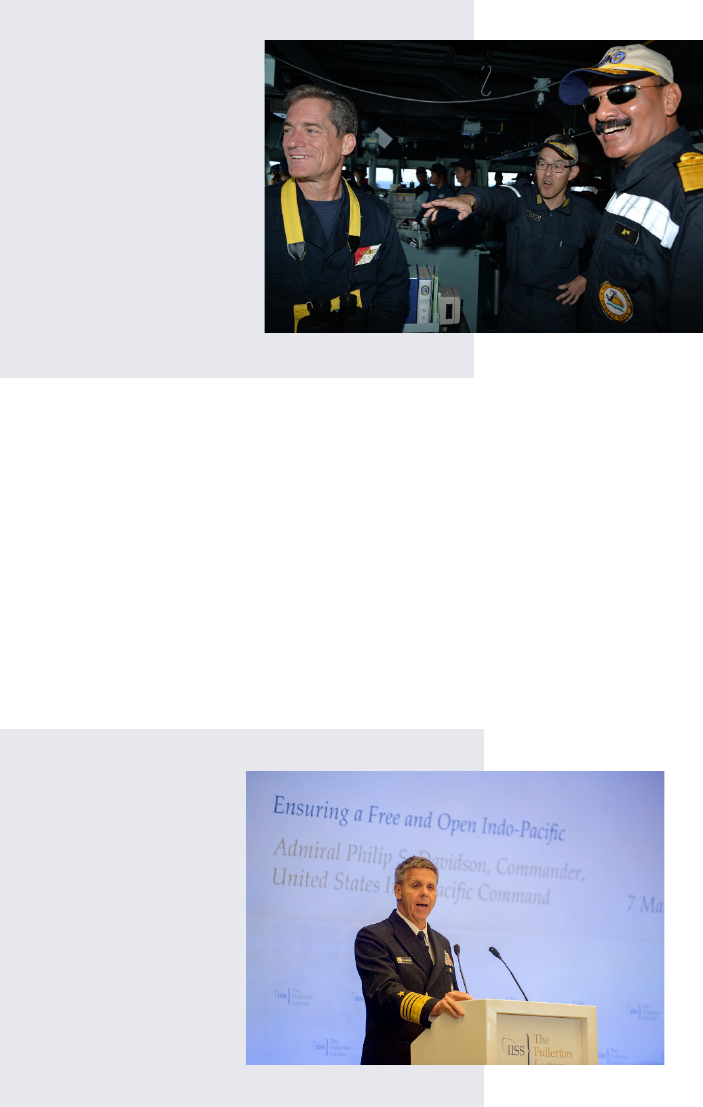
Indo- Pacific Strategy Report
46
partner since 2014. The exercise has
increased our ability to operate
trilaterally, including via real-time
information sharing, and has increased
in complexity over time to incorporate
surface, amphibious, and air
components. Underpinning this
cooperation is the State Department-
led trilateral dialogue which completed
its 9th iteration in April 2018. This
dialogue enhances trilateral
cooperation in the areas of
connectivity and infrastructure
development, counter-proliferation, counterterrorism, maritime security and domain awareness, and
HA/DR. The first-ever trilateral meeting between the leaders of the United States, India, and Japan
took place in November 2018 at the G20 meeting.
STRENGTHENING REGIONAL INSTITUTIONS THROUGH
MULTILATERAL ENGAGEMENT
The United States continues to support ASEAN centrality in the regional security architecture, and
the U.S. free and open Indo-Pacific strategy seeks to further empower it. The United States and
ASEAN share common values, and ASEAN is a key partner in promoting the values and policies
enshrined in the U.S. Indo-Pacific Strategy:
freedom of the seas; market economics;
good governance; and respect for an order
based on clear and transparent rules. As
ASEAN nations support one another to
maintain the freedom, sovereignty, and
territorial integrity of countries within the
region, this cohesion strengthens
ASEAN’s voice. The United States
respects ASEAN’s consensus based
decision-making model, and we believe the
more ASEAN speaks with one voice, the
more it is able to maintain a region free
from coercion.
A critical part of our engagement is meaningful work with various ASEAN-based institutions. At the
group’s invitation, the United States joined the East Asia Summit (EAS) – chaired by the rotating head
of ASEAN – and together we have made it the region’s leading forum for addressing political and
MALABAR 2018 was
the 22
nd
rendition of the
exercise and the first
time hosted off the
coast of Guam.
Photo by the U.S. Department of
Defense
Commander of U.S.
Indo-Pacific
Command Admiral
Davidson delivers a
speech on the free
and open Indo-
Pacific in Singapore,
March 7, 2019.
Photo by the U.S. Department of
Defense

Indo- Pacific Strategy Report
47
security challenges. Since
1994, the United States has
been an active member and
contributor to the ASEAN
Regional Forum (ARF),
utilizing the forum to
strengthen functional
multilateral cooperation
across a range of
transboundary traditional
and non-traditional security
challenges facing the Indo-Pacific. The ARF,
led by ministers of foreign affairs, is an ideal
platform for a truly networked region. The
Department has made significant progress in
recent years to enhance our defense and security
relationship with ASEAN. Through these
efforts, we are continuing to build on the desire
of ASEAN countries to better share
information with one another and pursue a
framework to enhance regional MDA.
The Department has enjoyed constructive
engagement with our ASEAN colleagues in the
ADMM-Plus and subordinate mechanisms,
such as the Experts’ Working Group, since the
formal establishment of the ADMM-Plus in
2010. U.S. Secretaries of Defense have attended
every ADMM-Plus ministerial meeting since
2010, and we have matched this participation
with active engagement in the ADMM-Plus
subordinate mechanisms.
In working with the ADMM-Plus, we seek to
complement U.S. efforts in the EAS, the ARF,
and other ASEAN fora. We use this formal
multilateral engagement mechanism with
ASEAN to complement our bilateral and
trilateral engagements. We have bolstered our
ties further by continuing to host informal U.S.-
ASEAN defense ministers meetings in
BUILDING PARTNER CAPACITY,
STRENGTHENING REGIONAL SECURITY
NETWORKS, AND ENHANCING SHARED
UNDERSTANDING
Since its inception in 1995, the Daniel K. Inouye Asia-
Pacific Center for Security Studies (DKI APCSS) has
promoted a networked region through its executive
education programs, and a network of now more than
12,000 alumni. During in-resident courses each
involving over 100 fellows from more than 35 countries,
multinational cohorts have developed action plans such
as enhancing cross-border law enforcement information
exchange, mitigating migration emergencies at sea and
reducing human trafficking.
As part of MSI, the center brought together
representatives from the maritime focal points and
information-sharing hubs across ASEAN to develop
their national and regional information sharing
mechanisms, share best practices, and outline their
interagency action plans to enhance maritime shared
awareness in their nations and the region.
In 2019, DKI APCSS also co-hosted the Oceania
National Security Policy workshop with the Pacific
Islands Secretariat, which focused on the
implementation of the Boe Declaration, and
development of national security polices by Oceania
nations. This event highlighted the importance of
supporting intra-regional security relationships to share
best practices and align sub-regional priorities.
Admiral Davidson,
Commander of U.S. Indo-
Pacific Command, providing
opening remarks at the 14th
ASEAN Defense Ministers’
Meeting Plus Experts’
Working Group on HA/DR
co-hosted by the United States
and Malaysia at the Daniel K.
Inouye Asia-
Pacific Center for
Security Studies. 72
participants from 16 nations
participated.
Photo
by the U.S. Department of Defense
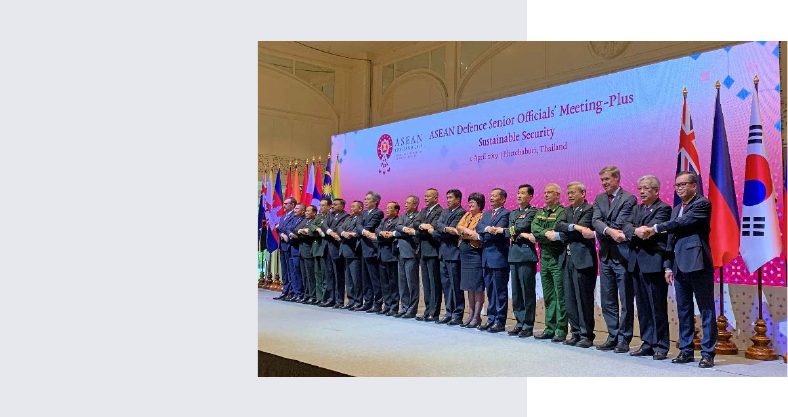
Indo- Pacific Strategy Report
48
September 2016, and in June and October 2018 building on the success of our 2014 meeting.
Thailand is the ASEAN Chair for 2019, and we continue to work with Bangkok to co-organize the
ASEAN-U.S. Maritime Exercise (AUMX), approved by the Defense Ministers during the ADMM in
October. The AUMX will take place in September 2019 in Bangkok and international waters in
Southeast Asia. This type of forward-leaning action by Thailand is a key example of its intent and
resolve to be a sub-regional leader. We continue to look for other ways and means to support this
type of effort through the SEAMLEI, previously known as the Gulf of Thailand Initiative on Maritime
Law Enforcement, which convenes the Coast Guards or maritime law enforcement agencies of
ASEAN member states to increase maritime law enforcement cooperation and information sharing.
SEAMLEI builds technical capacity using the latest technology for MDA, while also providing a
platform for dialogue among decision-making officials.
In October 2018, the ASEAN
Defense Ministers agreed to
conduct the first AUMX,
which Thailand agreed to
organize. To fulfill this
commitment, the United
States intends to focus on the
promotion of maritime
security and safety via shared
awareness, technical
cooperation, and sharing of
knowledge and expertise
between the United States
and ASEAN. The United
States is also examining the
viability of working with a willing ASEAN member state and ADMM-Plus partners to increase the
English language training (ELT) capacity for ASEAN military and defense officials. This concept
proposes joining efforts among ELT stakeholders to support a multinational ELT venue that
facilitates common learning, cultivates trust and confidence, and helps build a cadre of English
speaking counterparts across ASEAN defense establishments.
The Department also supports the recent re-establishment of the diplomatic quadrilateral
consultations – or Quad – between the United States, Australia, India, and Japan, which has convened
three times at the Assistant Secretary-level since November 2017. The Quad is an important forum
to discuss the respective Indo-Pacific visions of the four countries, all grounded in an affirmation of
ASEAN centrality and building on existing trilateral relationships. Consultations focus on upholding
the rules-based order in the Indo-Pacific, increasing connectivity consistent with international law and
standards, and coordinating on counter-terrorism and maritime security efforts.
ASEAN Defense
Senior Officials’
Meeting-Plus
Sustainable
Security, Thailand,
April 4, 2019.
Photo by the U.S. Department of
Defense

Indo- Pacific Strategy Report
49
EMERGING INTRA-ASIAN SECURITY RELATIONSHIPS
Improving security relations among Indo-Pacific countries is critical to regional integration. The
Department encourages our allies and partners to develop interconnected security relationships. In
some cases, and in recognition of the changing security environment, countries are strengthening their
bilateral, trilateral, and multilateral security relationships on their own, and in others, the Department
is more directly encouraging new cooperation. As part of these growing ties, countries are signing
new defense agreements and arrangements; enhancing training, exercises, and operations; and building
partner capacity, helping stabilize the Indo-Pacific.
Countries in the region are recognizing the need to formalize closer security ties to safeguard shared
principles, including the peaceful resolution of disputes, as the region saw with Vietnam and Australia
elevating their relationship to a strategic partnership, and Japan and India significantly expanding their
defense and security ties. Key countries are also working together more closely on conducting training,
exercises, and even joint operations. Recent examples include, expanded Japan-Vietnam maritime
exercises and Indonesia’s proposal to conduct joint operations with Malaysia and the Philippines –
MARITIME SECURITY INITIATIVE: YEAR FOUR
DoD’s Indo-Pacific Maritime Security Initiative (MSI) – Section 1263 of the National Defense
Authorization Act (NDAA) for FY 2016 – was originally established as a five-year authority focused
on building partners’ maritime capacity. The NDAA for FY 2019 extended the authority through
December 2025 and expanded the scope of the initiative – now designated the Indo-Pacific MSI – into
South Asia. MSI authorizes the provision of training, equipment, supplies, and small-scale construction
to the Philippines, Vietnam, Indonesia, Malaysia, Thailand, Sri Lanka, and Bangladesh to enhance their
ability to “sense, share, and contribute” to maritime security and MDA; to create a common Regional
Maritime Picture; and to empower them to observe and control more effectively their own sovereign
maritime spaces, both individually and jointly.
In MSI’s first three years, DoD focused on enhancing information-sharing, interoperability, and
multinational maritime cooperation. To increase information-sharing, DoD has connected the MSI
recipient nations’ Maritime Command and Control centers through the installation of secure
information-sharing networks, and Field Information Support Tool communications systems. MSI
funding has also been used to field common ISR platforms such as an Aerostat, SABIR ISR sensor
packages, unmanned aerial systems, and upgrades to High Endurance Cutter (WHEC) vessels to foster
interoperability among the region’s maritime forces. For example, the Philippines and Vietnam operate
and maintain their WHECs while conducting MDA missions in the South China Sea and multinational
training exercises.
With MSI support, the U.S. Navy has increased the scope of the SEACAT Exercise to make it a truly
regional maritime security exercise in which partners operationalize key skills – such as interdiction –
and communications systems provided through MSI. MSI has also enabled DoD to contract civilian
vessels for the exercise to simulate real-world interdiction and boarding scenarios more effectively.
One of MSI’s primary goals in FY 2019 is to enhance interoperability through common platforms.
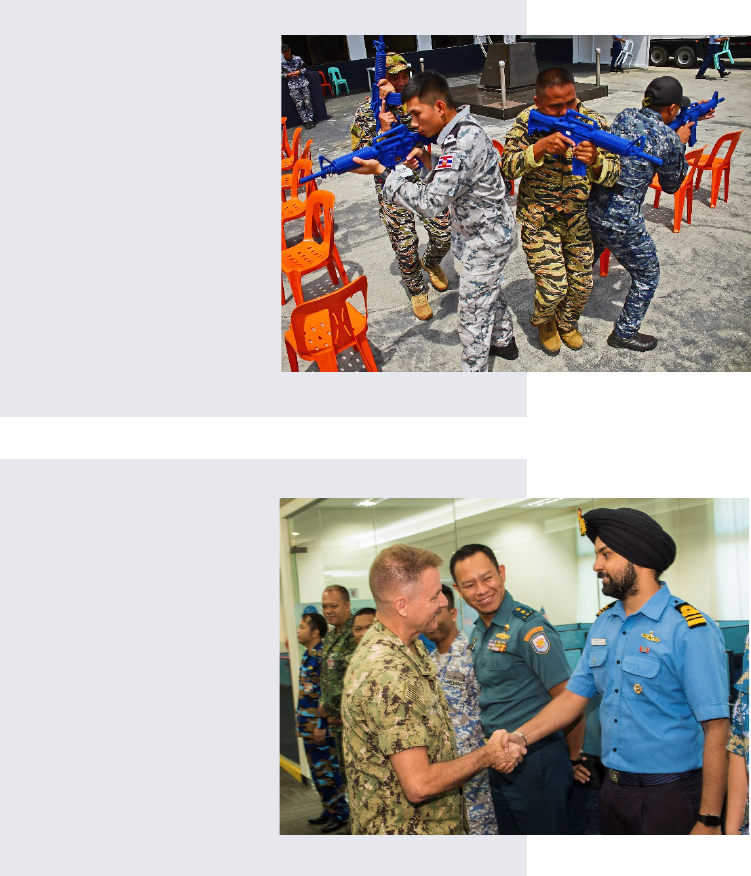
Indo- Pacific Strategy Report
50
including maritime counter-piracy patrols in the Sulu Sea. Regional capacity-building is increasing as
well, as seen with Japan’s efforts to improve Philippine maritime forces and India’s steps to deepen
its exchanges with Vietnam.
These closer relationships are not
limited to bilateral ones. Last
year, India hosted Japan and
Australia for its first ever high-
level trilateral dialogue in New
Delhi, where they discussed
maritime security, and other
security issues.
Singapore’s Information Fusion
Centre (IFC) is also an example of
how countries in the region are
collaborating to facilitate
information sharing and enhance
maritime security. Since its
inception in 2009, Singapore’s
IFC has served as a maritime
information hub for the region,
contributing actionable
information to regional and
global navies and coast guards to
cue timely operational responses
to maritime threats such as piracy
and drug smuggling. The IFC has
hosted over 100 international
liaison officers from over 20
countries. We are also
encouraged by the region’s efforts
to establish the “Our Eyes”
initiative, a platform to improve strategic information sharing between member countries.
Last December, the United States also welcomed the inauguration of India’s maritime IFC, which will
function as a regional platform for the exchange of information in the maritime domain among partner
nations. Likewise, Sri Lanka, whose strategic location in the Indian Ocean through which 70 percent
of maritime traffic passes, has outlined a vision to become a regional hub for logistics and commerce.
Supporting this vision, the U.S. Navy recently initiated a series of temporary cargo transfer initiatives
enabling non-lethal re-supply of passing naval vessels in Sri Lanka. These engagements serve as proof
of principle for a range of initiatives that would benefit regional connectivity and security, including
support to HA/DR. DoD also fully supports countries pursuing multilateral agreements and
Rear Adm. Joey Tynch,
commander, Task
Force 73, greets
international liaison
officers during a tour
of Singapore's IFC for
the SEACAT Exercise,
August 30, 2018.
Photo by Petty Officer 3
rd
Class
Christopher Veloicaza
A Royal Thai Coast
Guardsman (left), a
Philippine Navy Sailor
(center), and a Philippine
Coast Guardsman practice
tactical procedures during
a Visit, Board, Search, and
Seizure seminar as part of
the SEACAT Exercise in
Manila, August 28, 2018.
Photo by Petty Officer 1
st
Class Micah
Blechner

Indo- Pacific Strategy Report
51
arrangements to enhance regional security, including the 2002 ASEAN-China Declaration of Conduct
to lower tensions in the South China Sea.
The Department is also taking steps to support the law enforcement capacity and riparian domain
awareness of partner countries in the Mekong region to enhance border security and combat the
trafficking of drugs, wildlife, arms, and people.
Closer security relations in the region also benefit the United States’ ability to resource and implement
this strategy. Our National Defense Strategy states that “when we pool resources and share responsibility
for our common defense, our security burden becomes lighter.” Greater burden-sharing will
strengthen our ability to deter conflict and increase our flexibility in responding to challenges.
GLOBAL PEACE OPERATIONS INITIATIVE (GPOI)
The Indo-Pacific contributes more than one-third of all U.N. peacekeeping personnel, and many
countries have pledged additional contributions. India, Bangladesh, Nepal, and Indonesia are
consistently among the top 10 U.N. peacekeeping contributing countries. These and other regional
partners, such as Mongolia, provide critical enabling capabilities to U.N. operations. These
contributions help promote peace and security while advancing regional cooperation, confidence
building, and professionalization of security forces.
In partnership with the U.S. Department of State, USINDOPACOM will maintain strong regional
partnerships through Global Peace Operations Initiative (GPOI), which is the U.S. Government’s
primary tool to build partner capacity to support U.N. peace operations. GPOI’s 12 Indo-Pacific
partners include Bangladesh, Cambodia, Fiji, Indonesia, Malaysia, Mongolia, Nepal, the Philippines,
Sri Lanka, Thailand, Tonga, and Vietnam. Since 2016, GPOI has supported the U.N. Peacekeeping
Course for African Partners, which brings together Indian and U.S. Army instructors annually to train
African peacekeepers. Through GPOI, we will support training, exercises, equipment, and training
facility enhancements with a goal of strengthening partners’ preparation, deployment, and sustainment
capabilities.
Indo- Pacific Strategy Report
52
This page left intentionally blank

Indo- Pacific Strategy Report
53
Conclusion
he United States is a Pacific nation and has a natural and enduring interest in the Indo-Pacific.
For more than 70 years the United States, along with our like-minded allies and partners, has
helped underwrite a stable security environment that allowed the people, economies, and
nations in the Indo-Pacific to rise and prosper. Our vision for a free and open Indo-Pacific
encompasses values shared by our allies and partners in the region – one that emphasizes upholding
a foundation of mutual respect, responsibility, transparency, and accountability.
As great power competition returns, we will continue to invest, act, and orient ourselves to ensure that
the principled international order from which all countries in the region benefit endures. To uphold
a free and open Indo-Pacific, we will base our outreach and activities in the region on our strong
alliances and partnerships. We will also enhance our posture and presence while building the
capabilities of like-minded countries, as we promote a networked and more integrated region, engage
our burgeoning set of partners, and invest for the future.
T
Indo- Pacific Strategy Report
54
The United States will uphold our commitments and will act to defend our interests and those of our
allies and partners. At the same time, we maintain our expectation that our allies and partners will
contribute their fair share to security by:
Resourcing and investing sufficiently for their own defense to ensure deterrence and mitigate
vulnerabilities;
Cooperating in building partner capacity for third party partners in the region;
Upholding a rules-based international order (i.e., flying, sailing, and operating to uphold
international laws and norms);
Providing access needed for contingency response and resiliency;
Strengthening interoperability, including information sharing, with the United States and other
like-minded countries in the region; and,
Promoting and actively participating in region-led initiatives to uphold a free and open Indo-
Pacific.
The United States, along with our like-minded allies and partners, will continue to be engaged in this
dynamic and rapidly growing region. The Department of Defense, in conjunction with other U.S.
Government Departments and Agencies, regional institutions, and regional allies and partners, will
continue to ensure that the rule of law – not coercion and force – dictates the future of the Indo-
Pacific. We will build on our successes to ensure that this region remains peaceful, prosperous, and
secure for decades to come.
Indo- Pacific Strategy Report
55
ACRONYMS
A2/AD
Anti-Access/Area-Denial
ADMM
ASEAN Defense Ministers’ Meeting
APEC
Asia-Pacific Economic Cooperation
ARF
ASEAN Regional Forum
ASEAN
Association for Southeast Asian Nations
AUMX
ASEAN-U.S. Maritime Exercise
BMD
Ballistic Missile Defense
BUILD Act
Better Utilization of Investments Leading to Development Act
CARAT
Cooperation Afloat Readiness and Training
CCP
Chinese Communist Party
CNMI
Commonwealth of the Northern Mariana Islands
CFC
Combined Forces Command
DoD
U.S. Department of Defense
DPRK
Democratic People’s Republic of Korea
EAS
East Asia Summit
ECC
Enforcement Coordination Cell
EDCA
Enhanced Defense Cooperation Agreement
ELT
English Language Training
FMF
Foreign Military Financing
FMS
Foreign Military Sales
FONOP
Freedom of Navigation Operations
HA/DR
Humanitarian Assistance and Disaster Relief
IFC
Information Fusion Centre
IMET
International Military Education and Training
ISIS
Islamic State of Iraq and Syria
ISR
Intelligence, Surveillance and Reconnaissance
JSDF
Japan Self Defense Forces
MDA
Maritime Domain Awareness
MSI
Maritime Security Initiative
NATO
North Atlantic Treaty Organization
PLA
People’s Liberation Army
PRC
People’s Republic of China
ROK
Republic of Korea
SEACAT
Southeast Asia Cooperation and Training
SEAMLEI
Southeast Asia Maritime Law Enforcement Initiative
UNSCR
United Nations Security Council Resolution
USFK
United States Forces Korea
USINDOPACOM
United States Indo-Pacific Command
WHEC
United States Coast Guard High Endurance Cutter

Indo- Pacific Strategy Report
56
